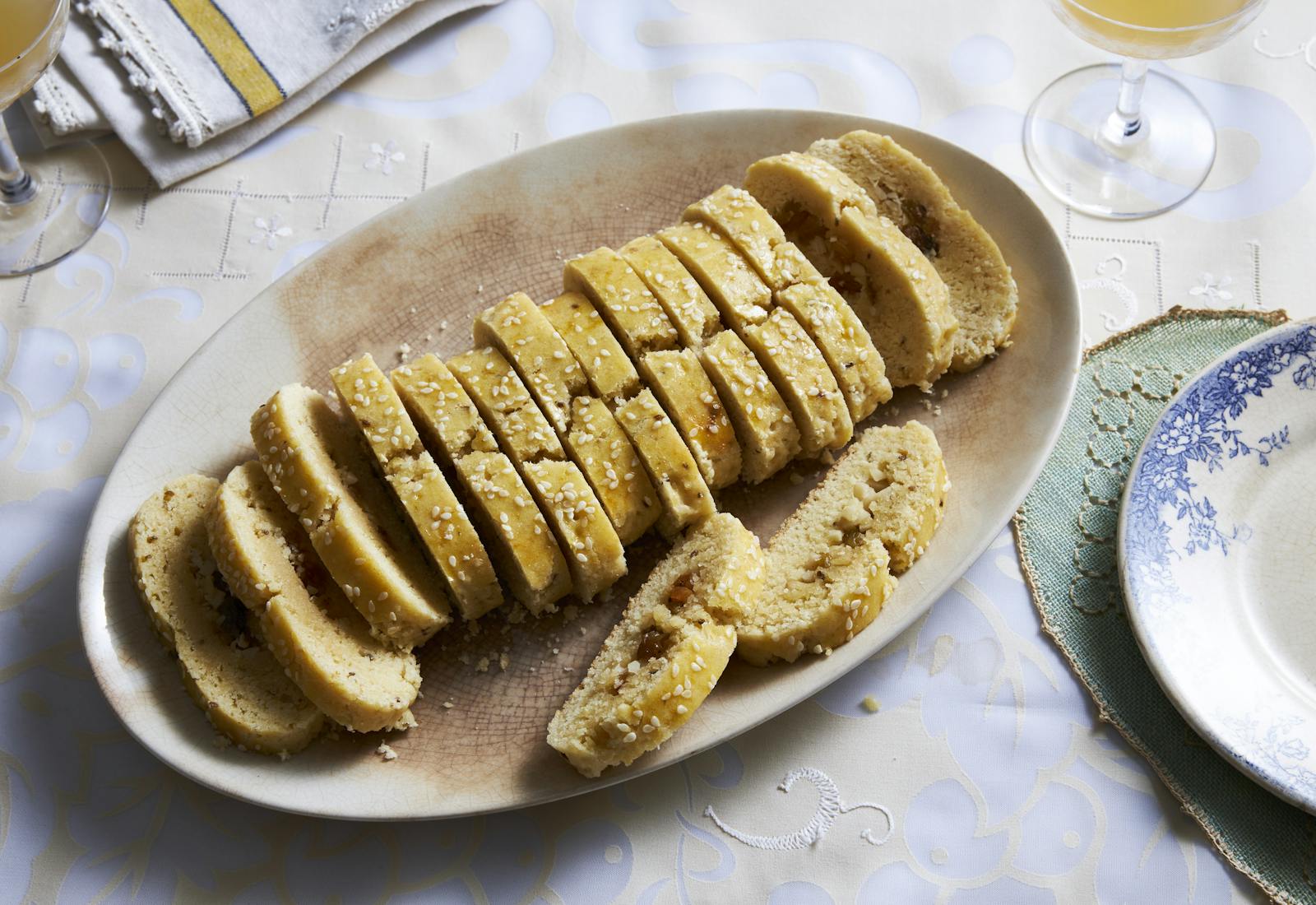Our Best Recipes From North Africa’s Jewish Communities
28 Recipes
Our Best Recipes From North Africa’s Jewish Communities
28 Recipes
The Shabbat and holiday tables of Jewish families from North Africa are vibrant and often vegetable laden, but they are also wonderfully varied, representing several different historical communities.
Jews have called North Africa home for approximately 2,000 years, with some arriving as early as about 300 BCE in what’s now Libya. According to the Roman Jewish historian Josephus, by the first century CE, half a million Jews lived in present-day Tunisia. More than a thousand years later, during the Spanish Expulsion, many Sephardi Jews fled south across the Strait of Gibraltar bringing with them their cooking traditions. And by 1948, approximately half a million Jews lived in the Maghreb, but today, there are only a few thousand remaining.
There are dishes that are unique to many of the Maghrebi communities, like the burnt Tunisian spinach stew p’kaila or Libyan mafrum, which is made by stuffing slices of vegetables with meat, frying them, and then simmering them in a tomato-based sauce. Even within Morocco, Shabbat stews — known locally as hamin, adafina, or skhena — vary from town to town, explains culinary scholar Claudia Roden in “The Book of Jewish Food: An Odyssey From Samarkand to New York.”
But there are also shared dishes like hand-rolled couscous, which is made across the Maghreb. And many Jewish families from here serve fish in a tomato sauce as a first course at Shabbat dinner. But, “the sauce’s components change depending on whether it’s being cooked by a Moroccan, Tunisian, or Libyan cook,” Leah Koenig explains in “The Jewish Cookbook.”
Like all cuisines, the cooking of North Africa’s Jews reflect what was grown nearby including tomatoes, peppers, eggplants, lemons, and more that thrive in warmer climes. You will find these in many of the recipes in this collection. We hope you will try them in your home.
Looking for more Jewish recipes from around the world? Explore our full archive here and check out our cookbook “The Jewish Holiday Table: A World of Recipes, Traditions & Stories to Celebrate All Year Long.”
Recipes in This Collection
1. Moroccan Eggplant, Tomato, and Zucchini Kamfounata (Ratatouille)
2. Salade Cuite (Cooked Pepper and Tomato Salad)
Shabbat
3. Salade de Betteraves au Cumin (Beet Salad with Cumin)
Shabbat
4. Fava Bean Soup With Harissa
Sukkot
5. Tomato Salad With Capers
6. Harissa
7. Matbucha with Jalapeño
8. Omelette Juive (Algerian Omelette)
9. Libyan Shakshuka
10. Poisson à la Marocaine (Fish Patties in Tomato Sauce)
Shabbat
11. Spicy Moroccan Fish
Shabbat
12. Spicy Moroccan Fish Crudo
13. Chraime (Fish and Peppers Stewed in Spiced Tomato Sauce)
14. Hand-Rolled Couscous
Cooking Projects
15. P'kaila (Burnt Spinach, Bean, and Sausage Stew)
16. Boulettes à l'oignon (Meatballs with Onion)
Shabbat
17. Poulet aux Olives (Chicken with Olives)
Shabbat
18. Pastela (Layered Beef, Potato, and Egg Casserole)
Baking Projects
19. Saffron-Lemon Chicken
Yom Kippur
20. Ma'akud (Libyan Potato Casserole With Beef and Vegetables)
21. Beef Cheek Tagine
22. Asada de Cordero con Alcachofas (Braised Lamb Shoulder With Artichokes)
Passover
23. Mafrum (Libyan Stuffed Vegetables)
Cooking Projects
24. Boulou (Orange Blossom Cookies With Seeds and Nuts)
Yom Kippur
25. Moroccan Sfenj
Passover
26. Mufleta (Moroccan Crepes)
27. Rifat (Moroccan Tea Biscuits)
28. Mint Tea With Pine Nuts, Honey, and Lemon
Passover
Shared by Elle Brosh
1. Moroccan Eggplant, Tomato, and Zucchini Kamfounata (Ratatouille)
Yield: 6 servingsTime: 1 hour, plus 1 hour prep timeShared by Elle Brosh

1. Moroccan Eggplant, Tomato, and Zucchini Kamfounata (Ratatouille)
Yield: 6 servingsTime: 1 hour, plus 1 hour prep timeSimilar to the beloved ratatouille Niçoise of Nice, France, this Moroccan dip called kamfounata is made with eggplant, tomato, and zucchini — it’s stewy, saucy and perfect for dipping. Instead of using fresh tomatoes, Elle Brosh’s family uses tomato paste, creating a deeply flavorful dip that can be enjoyed hot or cold. Let this dish sit overnight in the refrigerator for the flavors to fully meld and come together. Enjoy with bread and j’ben.
Read more about Elle Brosh in “Cooking My Way Back to My North African-Jewish Roots” and try her recipes for J’ben (Homemade Moroccan Cheese) and Salade Merk Hzina (Chopped Salad).
Ingredients
- 2 large eggplants, roughly chopped
- 2 red bell peppers, roughly chopped
- 2 small zucchini, roughly chopped
- 1 large yellow onion, roughly chopped
- 4 garlic cloves, peeled and minced
- 6 oz. tomato paste
- 2 tablespoons red wine vinegar
- 2 tablespoons extra virgin olive oil
- Salt and pepper to taste
Preparation
Step 1
Sprinkle the eggplants with salt and let sit for 1 hour to draw out the juices. Rinse and pat dry.
Step 2
Heat 2 tablespoons of oil in a large stew pot over medium heat and add the onions and garlic and a small pinch of salt. Sweat down until translucent, around 5 minutes. Add the tomato paste to the pan and stir to combine.
Step 3
Add eggplant, zucchini, and bell peppers to the pan, cover and cook over medium heat. Stir every ten minutes, for 35-40 minutes, until vegetables reduce about halfway in size.
Step 4
Right before vegetables reach tenderness, add in the red wine vinegar. Stir to combine. Taste and add more salt, pepper, or red wine vinegar if desired.
Step 5
Remove from heat. Serve hot or cold, with bread and j’ben cheese.
Shared by Simone and Marc Azoulay and Marie Salomé Peyronnel
2. Salade Cuite (Cooked Pepper and Tomato Salad)
Yield: approx 4 cupsTime: 20 min + 2-3 H inactiveShared by Simone and Marc Azoulay and Marie Salomé Peyronnel
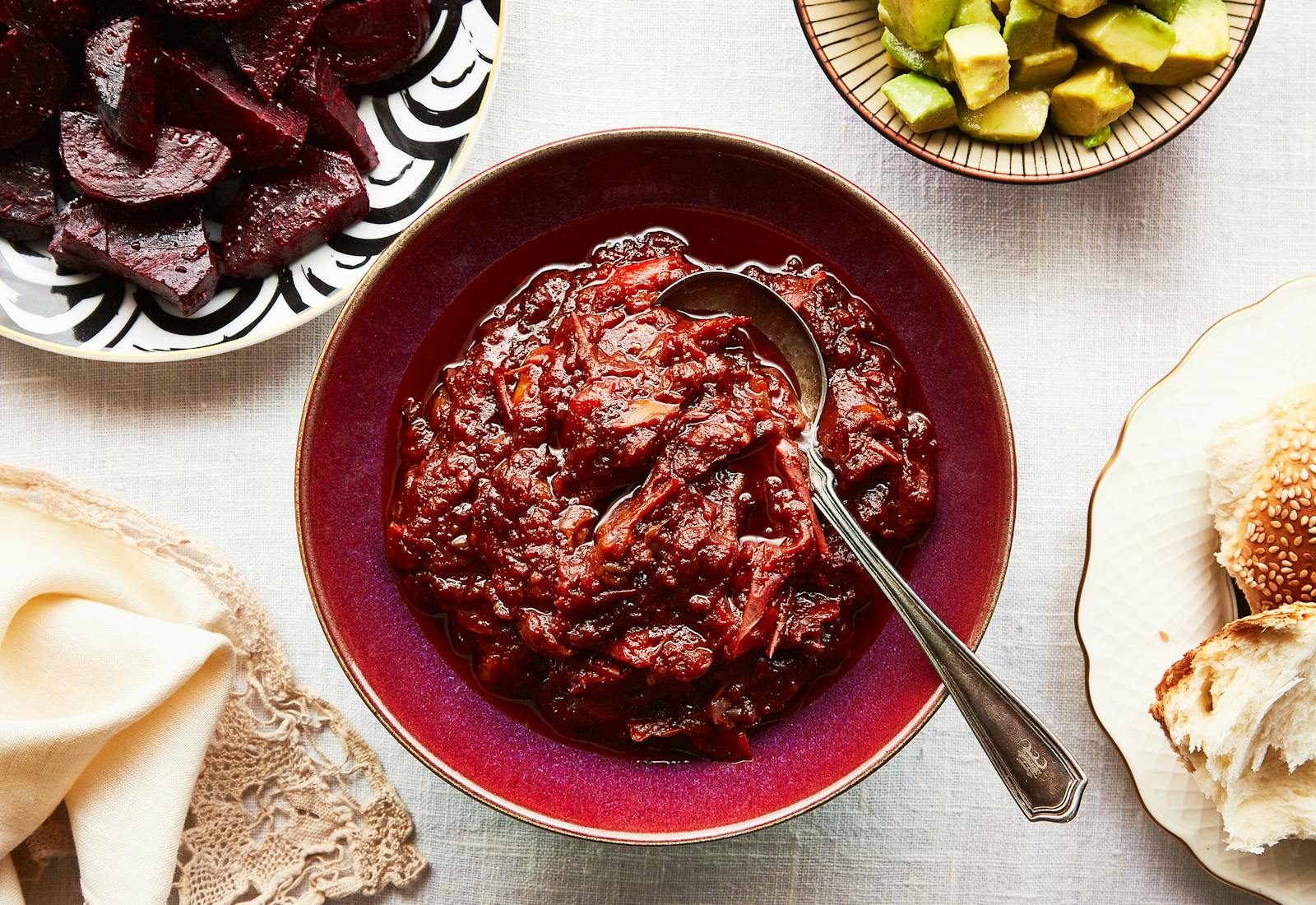
2. Salade Cuite (Cooked Pepper and Tomato Salad)
Yield: approx 4 cupsTime: 20 min + 2-3 H inactiveWhile Simone Azoulay changes her Shabbat menu in Paris every week, this jammy cooked Moroccan salad of tomatoes and peppers is the one constant, explains her son Marc, who also makes the dish with his wife Marie at their home in New York City. It’s best when allowed to slowly cook for hours, so be sure to start it with plenty of time before dinner.
Read more about their family’s Shabbat dinners in “Whether in Paris, New York, or Beyond, Marc Azoulay Always Makes Time for Shabbat Dinner” and try her recipes for chicken with olives and saffron, fish patties simmered in tomato sauce, and cumin-laced beets.
Ingredients
For the salad:
- 5 tablespoons olive oil
- 6 large bell peppers (mix of red, yellow and orange), thinly sliced
- 3 cloves garlic, minced
- 4 28 ounce cans crushed tomatoes
- 1-2 hot red peppers (or 3 small dry cayenne peppers), minced
- 1 teaspoon salt
For the Huile Rouge:
- 2 tablespoons olive oil
- 1 teaspoon cayenne
Preparation
Step 1
In a large heavy-bottomed pot, heat the oil over medium-low heat. Add the bell peppers and saute until they have softened, about 15 minutes. Add the minced garlic and cook until fragrant, about 2-4 minutes.
Step 2
Add the crushed tomatoes, hot peppers and salt and mix. Reduce the heat to low and simmer the mixture for at least 2 hours, stirring occasionally to prevent any sticking on the bottom of the pan. The mixture should become a deep red and very thick. Marie often cooks this down for more than 3 hours to get a super deep, silky salad.
Step 3
Once the salad is ready, pour in the huile rouge and cook, stirring often, for another 10 minutes. This will add a glossy sheen and a bit more spice.
Step 4
This salad can be made up to 3 days in advance.
Shared by Simone and Marc Azoulay and Marie Salomé Peyronnel
3. Salade de Betteraves au Cumin (Beet Salad with Cumin)
Yield: 6-8 peopleTime: 15 min + 1 H inactiveShared by Simone and Marc Azoulay and Marie Salomé Peyronnel
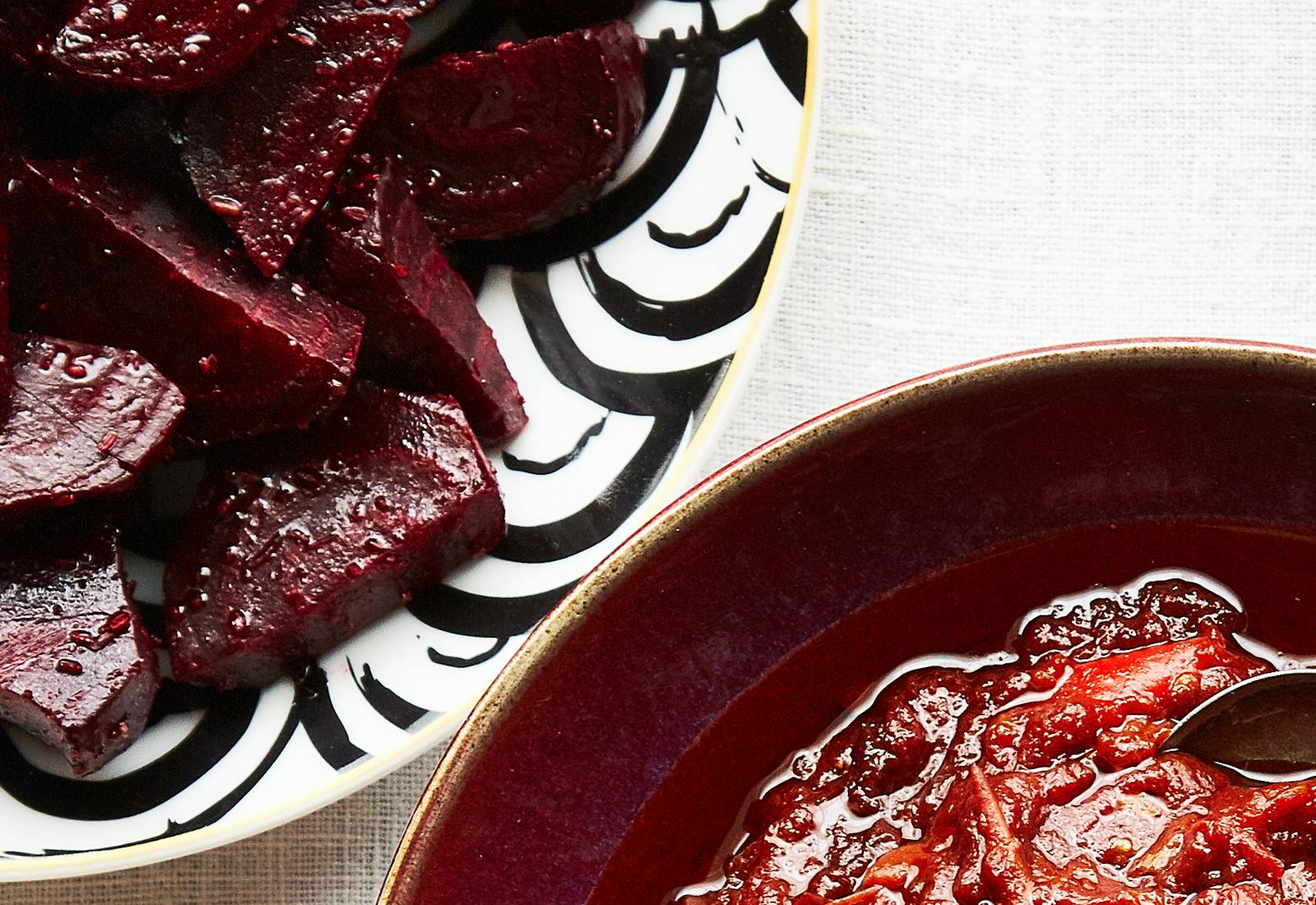
3. Salade de Betteraves au Cumin (Beet Salad with Cumin)
Yield: 6-8 peopleTime: 15 min + 1 H inactiveIn Marc Azoulay’s family, this salad is served as part of the first course on Shabbat with other salads like salade cuite, a jammy melange of tomatoes and peppers, and an avocado salad, which you can make by cubing avocado and dressing it with fresh lemon juice, olive oil, salt, and white pepper.
Read more about his family’s Shabbat dinners in “Whether in Paris, New York, or Beyond, Marc Azoulay Always Makes Time for Shabbat Dinner” and try his family’s recipes for chicken with olives and saffron, fish patties simmered in tomato sauce, and meatballs with onions.
Ingredients
- 4 medium beets
- 1 teaspoon of ground cumin
- 4 tbs of lemon juice
- 2 pinches of white pepper
- 6 pinches salt
Preparation
Step 1
Heat the oven to 400F.
Step 2
Scrub each beet then dry and wrap them in tin foil. Place the beets onto a baking sheet and roast for 55-60 minutes. You can check for doneness by slightly unwrapping one beet and trying to puncture it with a fork. It is ready when the beet is fork-tender.
Step 3
Remove the beets from the oven and allow to cool completely. Remove the skin from each beet with your hands or a small paring knife, then cut into 1/2 inch-thick wedges.
Step 4
Toss the beets with the rest of the ingredients and serve immediately.
Shared by Ron and Leetal Arazi
4. Fava Bean Soup With Harissa
Yield: 6 to 8 servingsTime: 45 minShared by Ron and Leetal Arazi

4. Fava Bean Soup With Harissa
Yield: 6 to 8 servingsTime: 45 minThis recipe is featured in our cookbook "The Jewish Holiday Table: A World of Recipes, Traditions & Stories to Celebrate All Year Long." For more holiday recipes from around the world, get your copy!
This recipe was shared by Ron and Leetal Arazi. Read more about their family in "Sukkah Dining: Moroccan Fava Bean Soup with Harissa."
Ingredients
- 1 tablespoon extra-virgin olive oil
- 1 teaspoon ground turmeric
- 5 tablespoons finely chopped garlic
- 3 cups (18 ounces) dried split fava beans, rinsed
- 7 cups water
- 3 tablespoons harissa
- 2 tablespoons canola oil
- 2 teaspoons fresh lemon juice
- Kosher salt
Preparation
Step 1
Heat the olive oil in a Dutch oven or other large heavy-bottomed pot over medium-high heat. Add the turmeric and 2 tablespoons of the garlic and cook until aromatic, about 1 minute. Add the fava beans and water and bring to a boil. Cover the pot, reduce the heat to low, and simmer, covered, until the beans are completely tender, 30 to 35 minutes.
Step 2
Meanwhile, in a small bowl, stir together the harissa, canola oil, lemon juice, the remaining 3 tablespoons garlic, and 2 teaspoons salt; set aside.
Step 3
Transfer the beans and the cooking liquid to a blender, add 1 tablespoon salt, and puree the soup until smooth; you may need to do this in batches.
Step 4
Return the soup to the pot, taste, and add more salt, if you like.
Step 5
Serve the soup in individual bowls, garnishing each one with a spoonful of the harissa topping. To make ahead, store the soup and the harissa topping separately in the refrigerator for up to 2 days and reheat the soup before serving.
Shared by Kathy Berrie
5. Tomato Salad With Capers
Yield: 4 - 6 servingsTime: 30minShared by Kathy Berrie
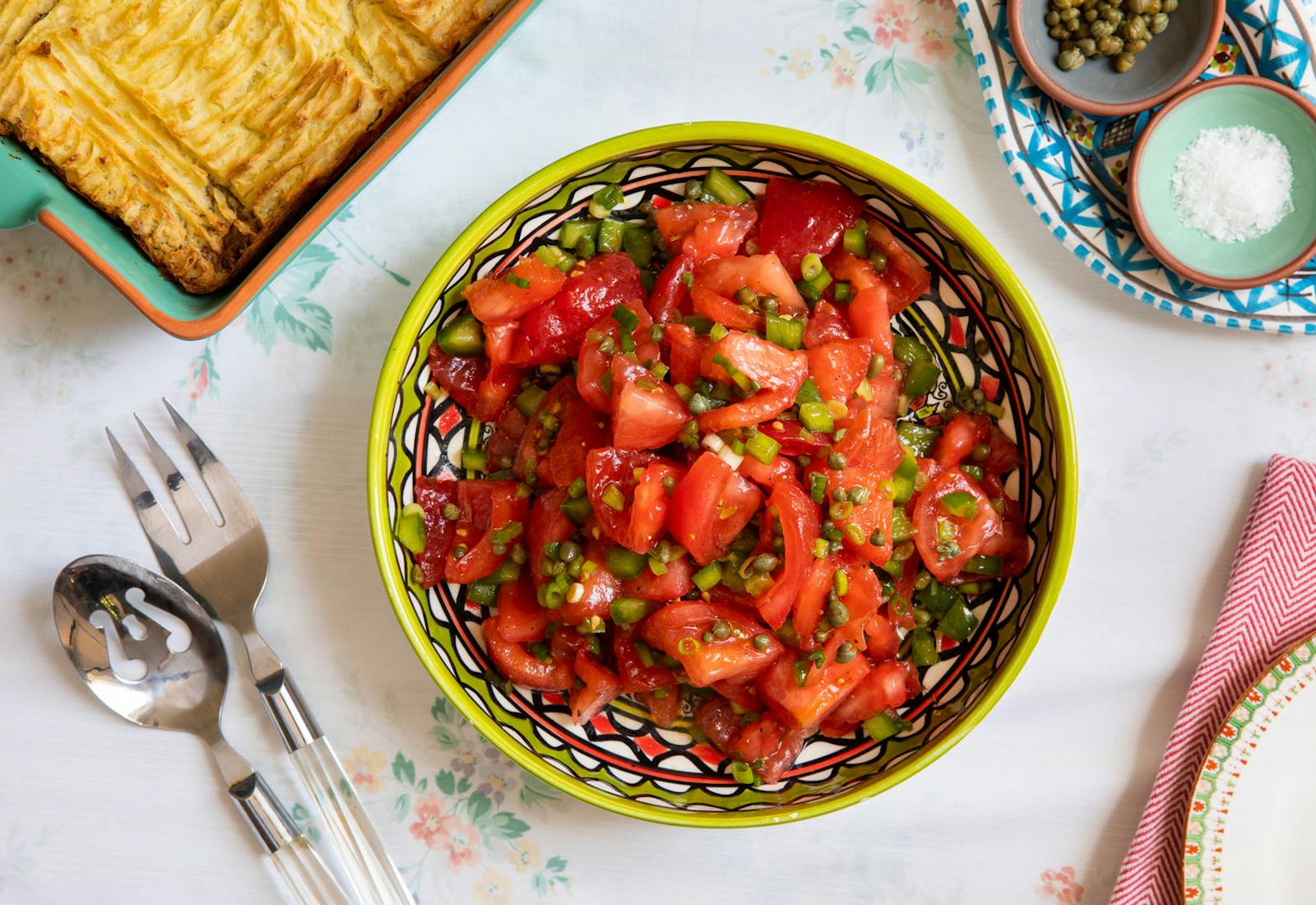
5. Tomato Salad With Capers
Yield: 4 - 6 servingsTime: 30minThis recipe was shared by Kathy Berrie. Read more about her family in "Memories of Morocco: Pastela + Tomato Salad" and try her recipe for pastela (layered beef, potato and egg casserole).
Ingredients
- 4 large tomatoes, peeled and deseeded, chopped into large chunks
- 1 medium green bell pepper, ¼” dice
- 3 tablespoons capers, drained
- 4-5 scallions, whites only, finely sliced
- ¼ cup extra virgin olive oil
- 2 tablespoons fresh lemon juice
- 2 teaspoons salt
- ½ teaspoon pepper
Preparation
Step 1
Place the tomatoes, green bell pepper, capers, and scallion in a medium bowl. Add the oil, lemon juice, salt and pepper. Toss to combine. Taste and adjust for seasoning adding more salt or lemon to taste.
Step 2
Serve immediately with your favorite summer spread or over couscous like Kathy
Shared by Joanna Bensimon
6. Harissa
Yield: 1 cupTime: 1 h and 30 minShared by Joanna Bensimon
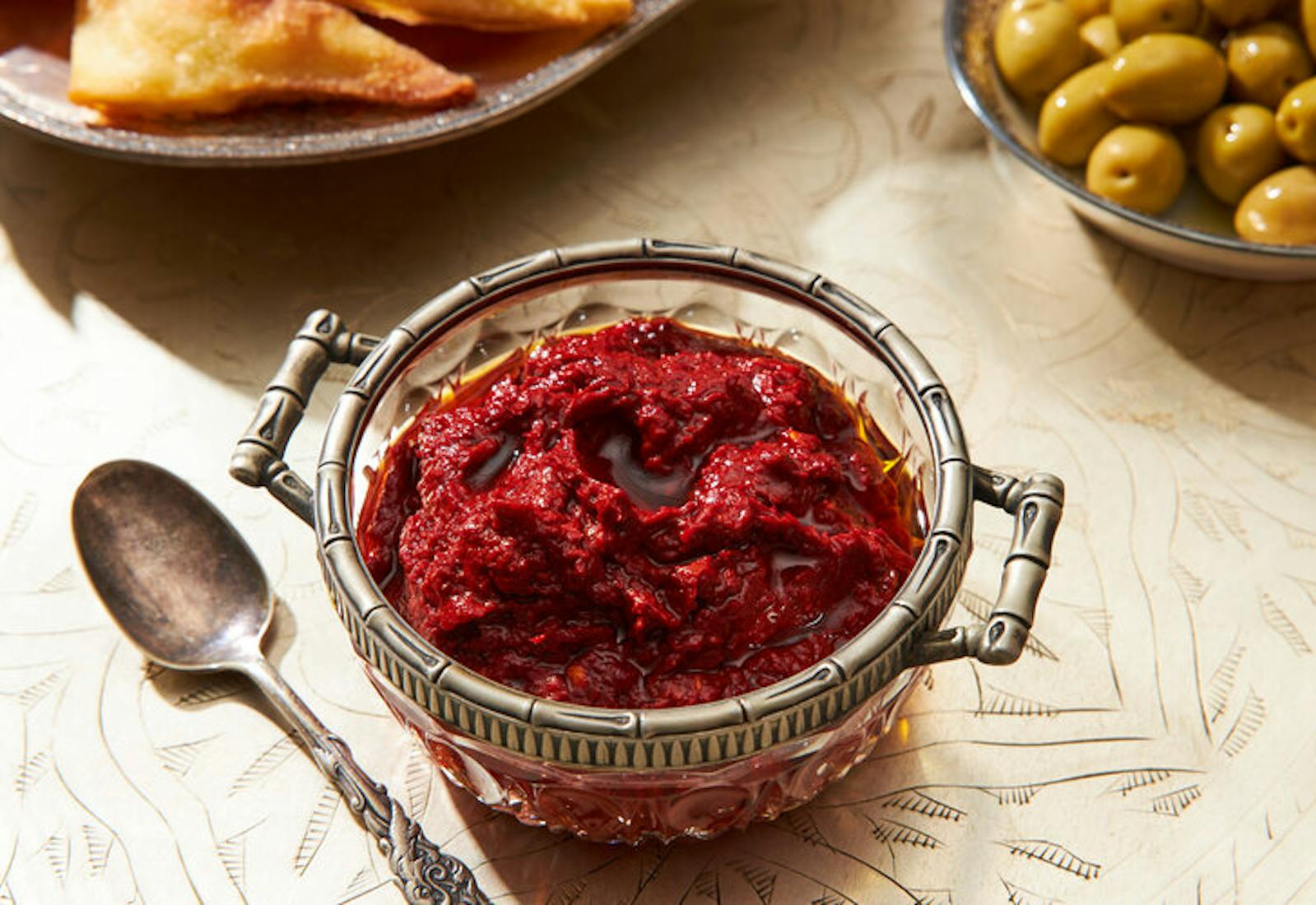
6. Harissa
Yield: 1 cupTime: 1 h and 30 minOn Saturday mornings, Joanna Bensimon would help her mother make harissa as she watched cartoons. “This was the perfect task to be given as my mother didn't cook on Shabbat but yet couldn't stay out of the kitchen or stay still,” she explains. As an adult, her mother would bring suitcases full of food when she visited, including her harissa. After one visit, Joanna mixed harissa with ketchup, which sparked the idea for her squeezable harissa company The Hamsa Brand. While Ora has always been in charge of the kitchen, she’s happy to let Joanna take charge of this recipe.
Read more about Joanna's family in "A Moroccan Shabbat Aperitif Tradition Finds a New Home in Queens" and try her recipes for Moroccan beef cigars, fava beans with cumin, and potato-filled pastels.
Ingredients
- 4 ounces dried ancho and/or guajillo chilis
- 4 - 6 dried chilis de arbol, depending on your heat preference
- 6 garlic cloves
- 1 teaspoon ground cumin
- 1 teaspoon kosher salt
- Olive oil for preserving
Preparation
Step 1
Soak all the dried chili peppers including the chilis de arbol in a pot with warm water for 1 hour.
Step 2
Strain the peppers and remove their seeds and stems. Lay the peppers over a paper towel-lined tray and set them aside to dry for about 15 minutes.
Step 3
Place the peppers and garlic cloves into a food processor. Process the mixture until a smooth paste is formed.
Step 4
Transfer the pepper and garlic paste into a large mixing bowl. Add the cumin and salt and mix well until combined. Taste to adjust any seasonings.
Step 5
Transfer the harissa paste into a 1 ½ cup sterile glass jar. Pour up to ½ cup of olive oil over the paste to seal the harissa.
Shared by Uriel Benzrihem
7. Matbucha with Jalapeño
Yield: 4 to 6 servingsTime: 2 hShared by Uriel Benzrihem
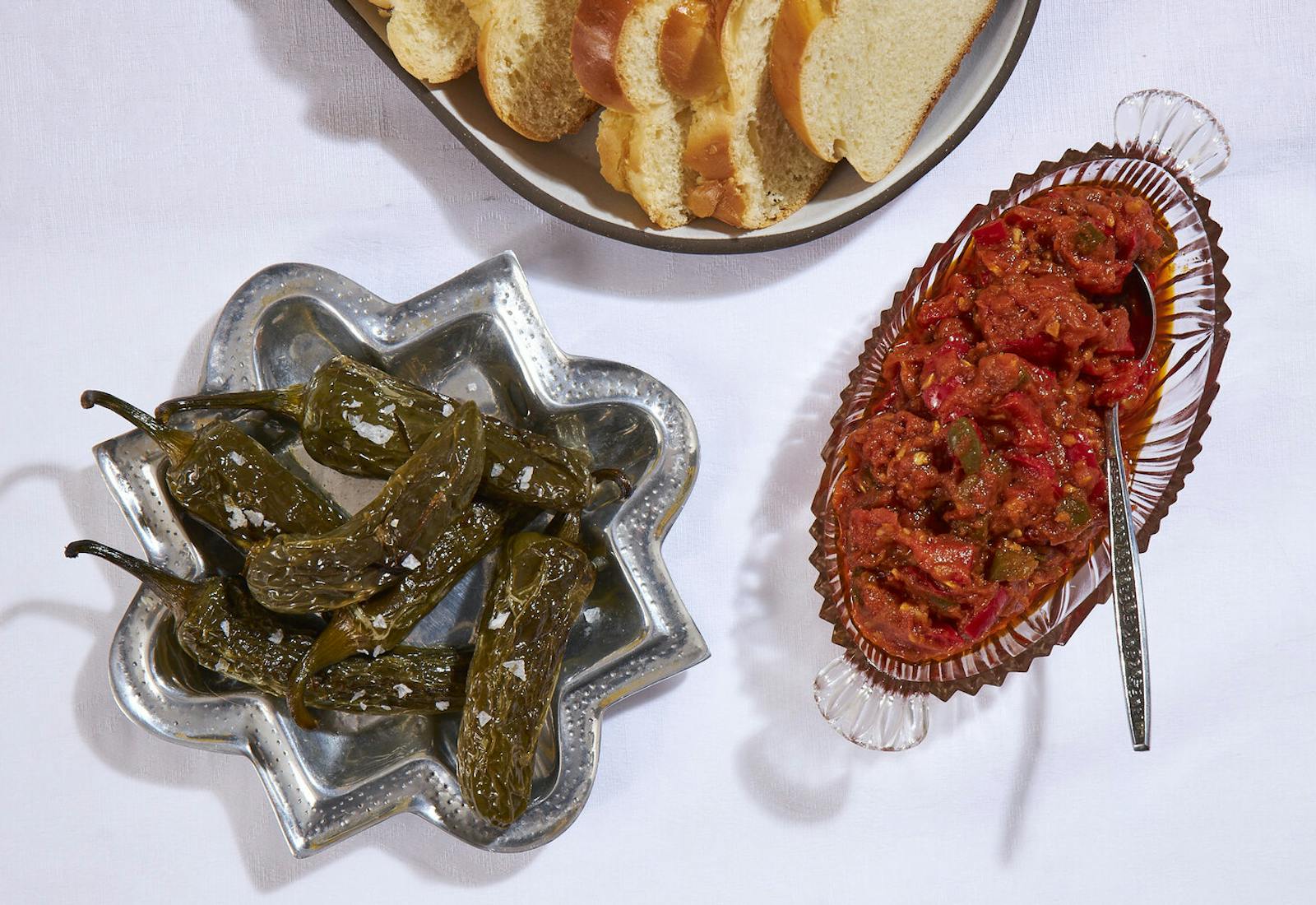
7. Matbucha with Jalapeño
Yield: 4 to 6 servingsTime: 2 hThis recipe was shared by Uriel Benzrihem. Read more about his family in "For Five Generations, This Family Has Marked Fridays With Chickpeas" and try his recipes for fried eggplant with garlic and cumin and moroccan chickpea stew with fish.
Ingredients
- 6 ripe plum tomatoes
- 1 red bell pepper, deseeded and chopped into ¼ inch pieces
- 1 jalapeño pepper, chopped into ¼ inch pieces
- 5 garlic cloves, finely chopped
- ¼ cup vegetable oil
- 1 teaspoon kosher salt
- 1 teaspoon sweet paprika
Preparation
Step 1
Bring 4 cups of water to boil. Place the tomatoes in a deep, heatproof bowl. Pour enough boiling water over the tomatoes to cover and set them aside for 3 minutes. Drain the water and peel the tomatoes.
Step 2
Cut the tomatoes into ½ inch cubes. Place the tomatoes into a dry saucepan over medium low heat. Add the bell pepper, jalapeño pepper, and garlic. Cook the vegetables, stirring every 10 minutes to prevent scorching. Cook for about 45 minutes to 1 hour or until the vegetable liquids have reduced.
Step 3
Add vegetable oil, salt and paprika and continue cooking, stirring often, until the tomatoes and peppers are jammy, about 45 minutes to one more hour.
Step 4
Serve the matbucha with pita or challah. Leftovers will hold in the refrigerator for 5 days.
Shared by Elle Brosh
8. Omelette Juive (Algerian Omelette)
Yield: 6 servingsTime: 45 minutesShared by Elle Brosh

8. Omelette Juive (Algerian Omelette)
Yield: 6 servingsTime: 45 minutesThis recipe comes from Elle Brosh’s great-grandmother, Zahra Ben Hamou, who was from Mascara, Algeria. She was known for making giant potato omelettes for her nine children to share. In addition to potatoes, other ingredients were added to the mixture to bulk it up, like spinach and peas. A North African omelette is thicker and fluffier, like a Spanish tortilla or Italian frittata, probably because of the strong Mediterranean influence in the region. Enjoy it straight from the oven.
Read more about Elle Brosh in “Cooking My Way Back to My North African-Jewish Roots” and try her recipes for Moroccan Eggplant Kamfounata (Ratatouille) and Salade Merk Hzina (Chopped Salad).
Ingredients
- 3 tablespoons extra virgin olive oil
- ½ lb Yukon gold or new potatoes, sliced into ¼” rounds
- 2 teaspoons fine sea salt
- ½ teaspoon freshly ground black pepper
- 1 tablespoon butter
- 1 yellow onion, sliced
- 4 garlic cloves, minced
- ½ teaspoon turmeric
- ½ lemon, juiced
- 10 large eggs
- ½ cup shredded mozzarella
- 2 cups fresh spinach
- ½ cup fresh or frozen peas
- ¼ cup parsley, chiffonade cut for garnish
Preparation
Step 1
Heat oven to 350°F. Then crumple up a large piece of parchment paper so it becomes malleable and line a 10” inch wide, 2” inch high cast iron pan with it and set aside.
Step 2
Heat the olive oil over medium heat in a separate 10” inch wide, 2-inch deep cast iron pan. Season the potatoes with salt and pepper on each side, then add to the heated oil. Fry on both sides, 4-5 minutes total, until golden brown and crispy. Remove from the pan and place on a paper towel lined plate to soak up the oil. Set aside.
Step 3
Add butter to the pan over medium heat and add the onion, garlic, turmeric, a pinch of sea salt and a crank of black pepper. Let the onions and garlic caramelize, around 7-8 minutes, stirring. Add the lemon juice to the pan, deglaze and turn off the heat.
Step 4
In a bowl, beat eggs together with 1 teaspoon of sea salt and a few cranks of black pepper. Gently mix the fried potatoes with the eggs, onion, and garlic and add to the lined cast iron pan. Sprinkle the cheese, spinach, and peas into the egg mixture and gently mix so everything is spaced out evenly in the pan.
Step 5
Put in the oven and bake until the center is no longer molten below the surface, about 20 minutes. The omelette will continue to cook as it cools, so it’s better to take it out when it looks like it's just about to be done. You want the end result to be fluffy, not completely solidified.
Step 6
Take out of the oven and let cool for 5-10 minutes. Hold opposite sides of the parchment lining and lift to transfer onto a serving plate. You can either tear the parchment and slide it out from underneath or flip onto another plate to remove and then flip back onto another plate so the baked side is facing upwards. Cut into slices and garnish with parsley. Serve fresh, while hot.
Shared by Nitza Kardish
9. Libyan Shakshuka
Yield: 6 - 8 servingsTime: 30min plus 4h cooking timeShared by Nitza Kardish
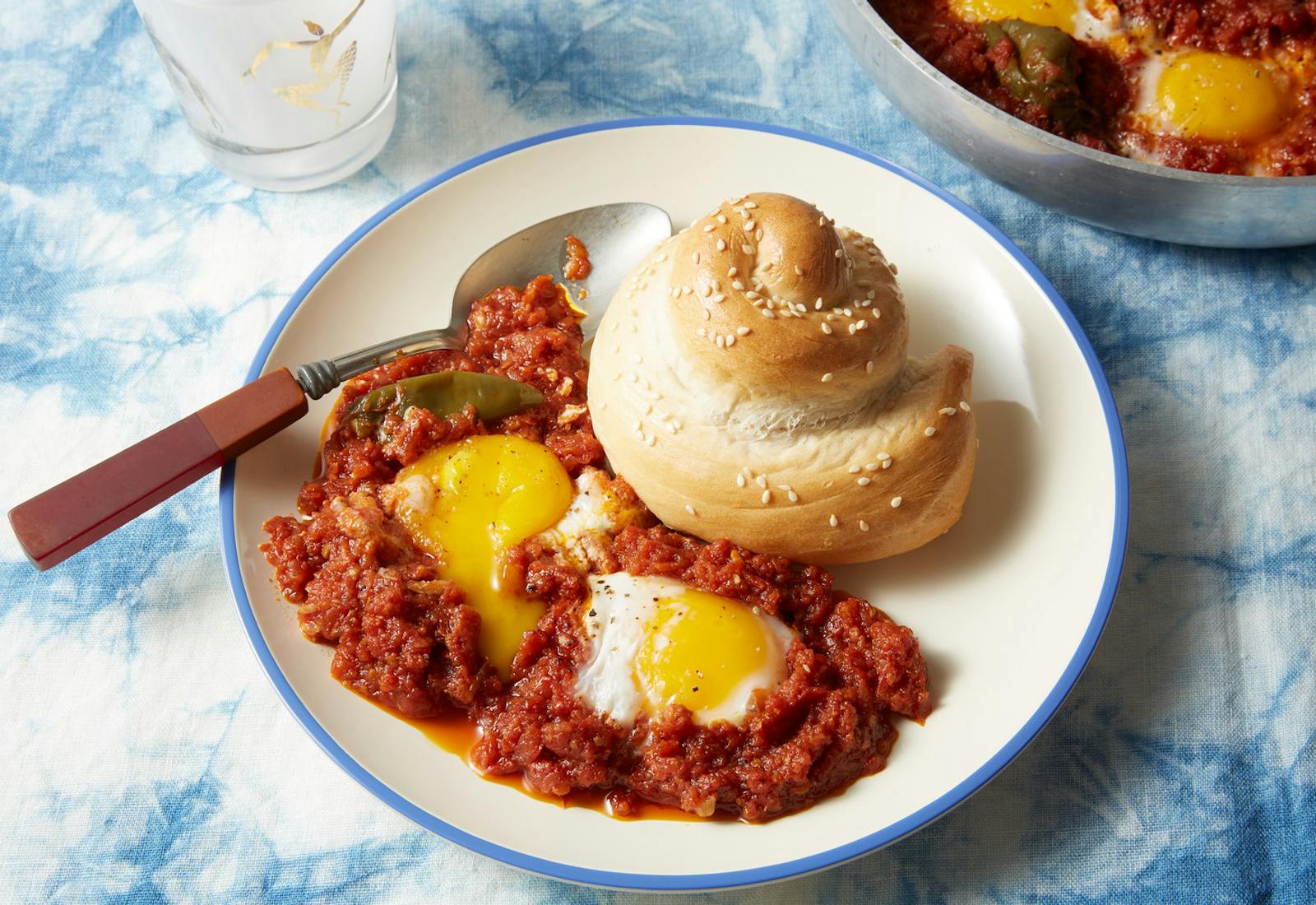
9. Libyan Shakshuka
Yield: 6 - 8 servingsTime: 30min plus 4h cooking timeThis recipe was shared by Nitza Kardish. Read more about her family in "A Libyan Shakshuka That Will Never Change" and try her recipes for sesame seed rolls, and ma'akud (potato casserole with beef and vegetables).
Ingredients
- ½ cup olive oil
- 5 lbs. tomatoes, grated
- Cloves from a head of garlic, peeled and smashed
- 1 tablespoon paprika
- 1 tablespoon salt
- 2 whole green chili peppers, like poblano, serrano, or jalapeño
- 6-8 eggs
Preparation
Step 1
Combine the olive oil, tomatoes, garlic, peppers, paprika, salt, and 2 cups of water in a large skillet or braiser.
Step 2
Bring to a simmer over medium-high heat, then lower to the lowest possible flame and cook for 4-5 hours. This may require moving your skillet to the smallest burner on the stove. Stir occasionally and add water, 1 cup at a time, as necessary until a deeply flavorful, thick, jammy base forms.
Step 3
To finish, gently crack the eggs over the sauce. Cover and cook on medium-high heat until the whites are hardened but the yolk is still runny, about 5 minutes. Serve immediately with homemade bread.
Step 4
Sauce can be frozen or stored in the refrigerator for up to 5 days.
Shared by Simone and Marc Azoulay and Marie Salomé Peyronnel
10. Poisson à la Marocaine (Fish Patties in Tomato Sauce)
Yield: 6-8 servingsTime: 2 HShared by Simone and Marc Azoulay and Marie Salomé Peyronnel
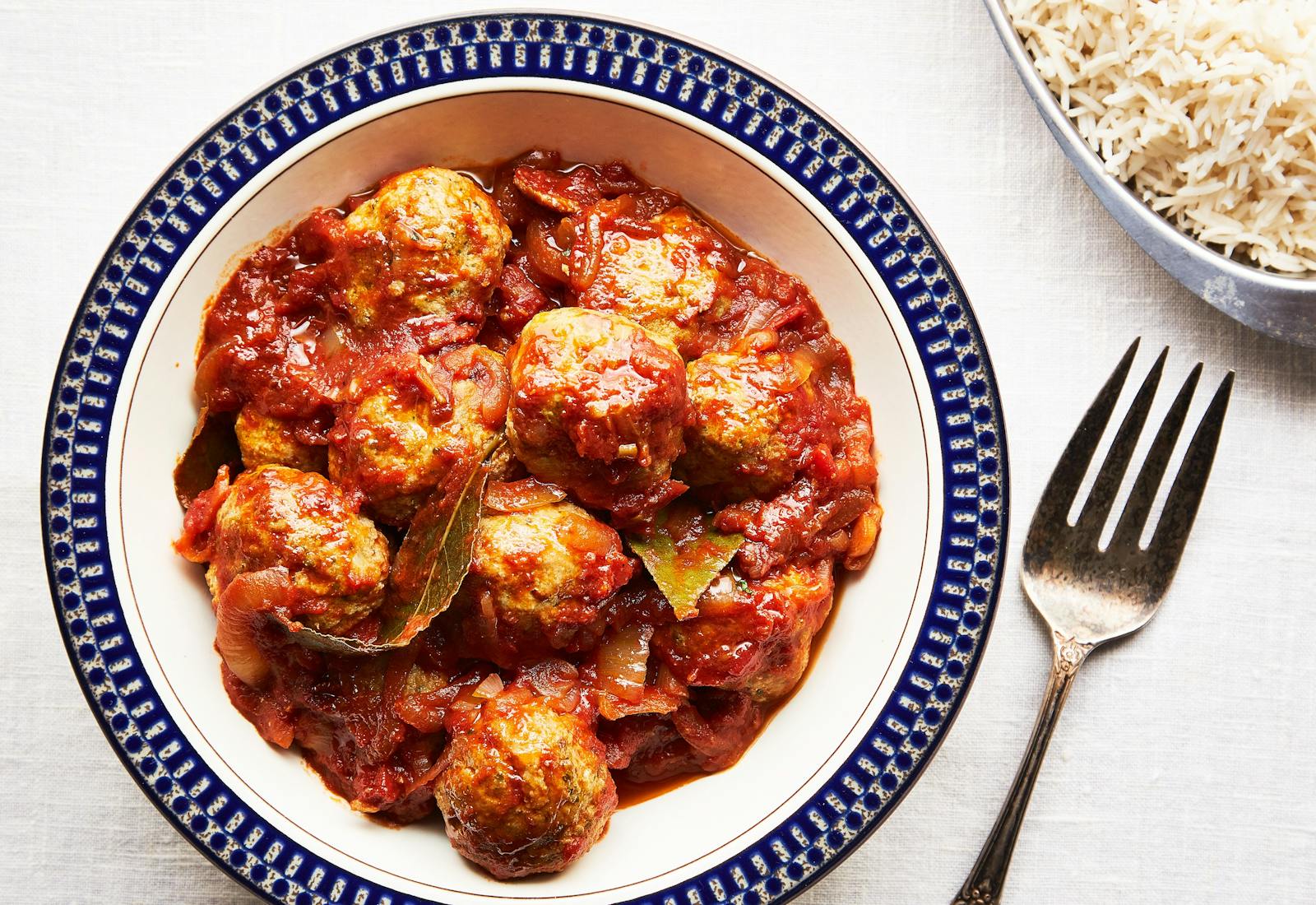
10. Poisson à la Marocaine (Fish Patties in Tomato Sauce)
Yield: 6-8 servingsTime: 2 HThese seasoned fish patties from Simone Azoulay’s family are first poached and then finished in a rich tomato sauce. You can serve this as a first course along with Simone’s salade cuite, a cooked salad of tomatoes and peppers and cuminy beets, or on its own. Be sure to have challah on hand for dipping.
Read more about her family’s Shabbat dinners in “Whether in Paris, New York, or Beyond, Marc Azoulay Always Makes Time for Shabbat Dinner” and try Simone’s recipes for meatballs with onions and chicken with saffron and olives.
Ingredients
For the fish balls:
- 3 lbs fresh cod filet
- 1 yellow onion, roughly chopped
- 3 eggs
- 1 bunch cilantro with stems, chopped
- 1 tablespoon salt
- 1 teaspoon white pepper
- 1 teaspoon nutmeg
- 1 teaspoon mace
- 2 1/2 tablespoons sunflower oil
For the sauce:
- 4 tablespoons olive oil
- 1 yellow onion, halved and thinly sliced
- 2 15oz cans crushed tomatoes
- 2 ½ tablespoons tomato paste
- 1 teaspoon salt
- ½ teaspoon white pepper
- 2 teaspoons cane sugar
- 4 bay leaves
Preparation
Step 1
Make the sauce: In a wide, heavy bottomed pot, heat the olive oil over medium-high heat. Place the sliced onion into the pot and saute for 4 minutes. Lower the heat to medium-low, cover and allow to soften for 15 minutes. Stir the onions every 5 minutes or so. Pour the crushed tomatoes, ¾ cup water, tomato paste, 1 teaspoon salt, ½ teaspoon white pepper, the cane sugar and bay leaves into the pot and stir. Reduce the heat to low and simmer for 30 minutes, adding up to 1 cup of water to achieve the desired consistency.
Step 2
Prepare the fish balls: In a food processor pulse the fish, chopped onion, eggs, cilantro, 1 tablespoon salt, 1 teaspoon white pepper, nutmeg, mace and sunflower oil. With oiled hands, form 24-26 balls, about 60 grams each. Place them onto a parchment-lined baking sheet.
Step 3
In a medium sized pot, bring water to a boil with 1 teaspoon of salt and a spoonful of sauce. Carefully place the fish balls into the water and cook for 5-7 minutes. This allows the balls to firm up before going into the sauce. Do this in batches.
Step 4
Place the fish balls into the sauce and simmer, covered for 10-15 minutes until they are cooked through.
Shared by Anna Masica
11. Spicy Moroccan Fish
Yield: 4-5 servingsTime: 50 minShared by Anna Masica
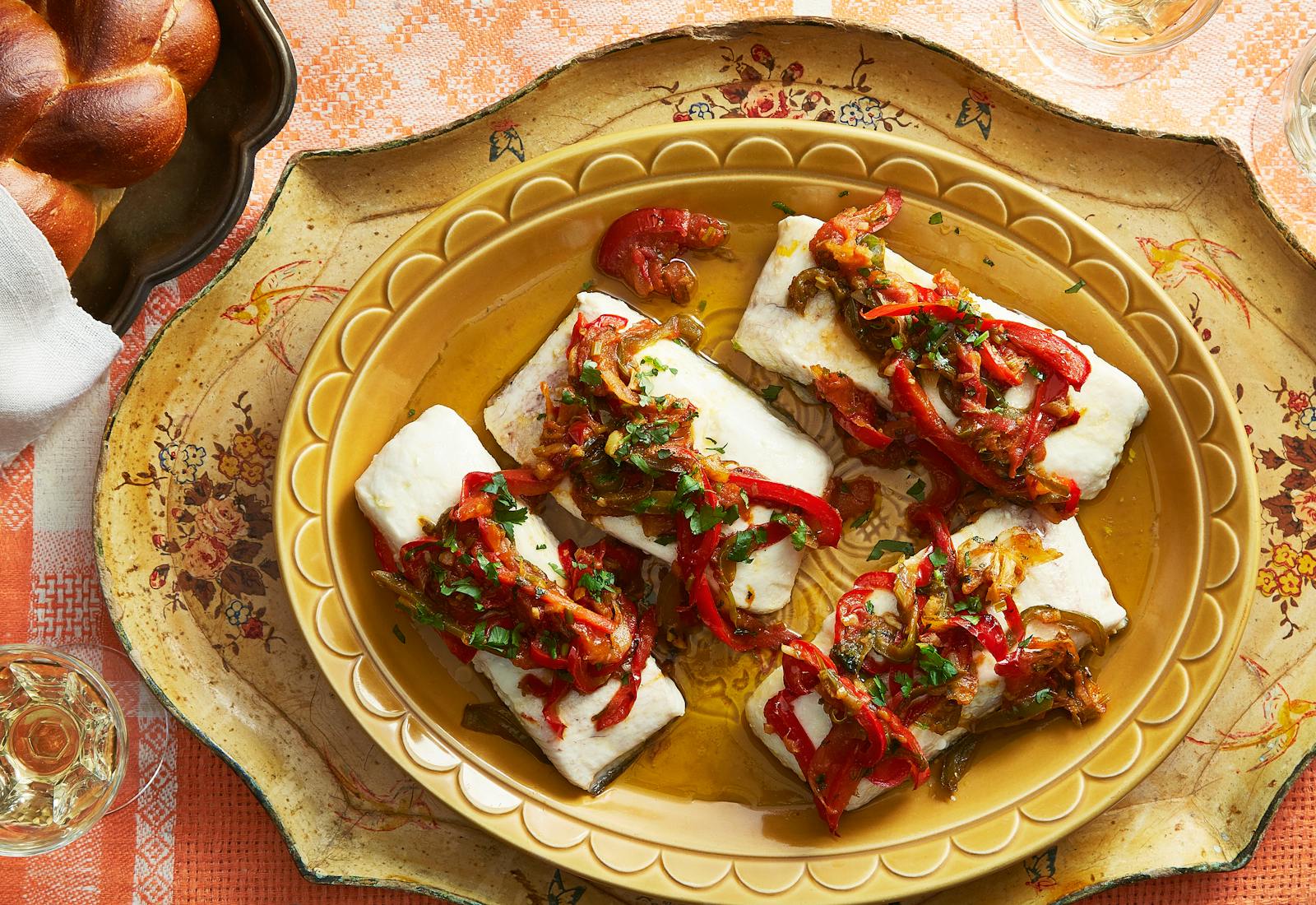
11. Spicy Moroccan Fish
Yield: 4-5 servingsTime: 50 minIn Moroccan, Algerian, Tunisian, and Libyan families, it’s common to prepare a spicy fish recipe for the start of Shabbat. This one comes from Anna Masica’s family and has been made in her Moroccan family for generations. “As my mom used to say, this is a dish that has all the nutrients in it,” Anna told us. She always helped her late mother make the recipe and eventually Anna wrote it down for her own kids when they were old enough to cook for themselves.
Starting as a simple vegetable saute, the mixture is seasoned with paprika, cumin, and turmeric. If you prefer a less spicy version, remove the seeds from the jalapeño before slicing it or skip it entirely and use half a green bell pepper instead. Once the sauce comes together, it’s poured over the fish — Anna uses salmon, but a flaky white fish would also work — then it’s baked until just cooked and served warm.
Every time Anna makes this dish, she feels it brings her closer to her mother, and helps keep her memory alive.
This recipe comes from a collaboration between Momentum and the Jewish Food Society. Find more recipes from this collection at "Recipes from the Momentum Community", created with the help of Rebecca Firsker and Ame Gilbert.
Ingredients
- 5 tablespoons olive oil
- 1 large red bell pepper, thinly sliced
- 1 large jalapeño, thinly sliced and seeded if desired
- 6 garlic cloves, finely chopped
- 2 roma tomatoes, thinly sliced
- 1 lemon, rind and pith removed, thinly sliced into rounds
- 1 bunch cilantro (leaves and all stems), chopped
- ½ teaspoon hot, sweet, or smoked paprika
- ½ teaspoon ground cumin
- ¼ teaspoon ground turmeric
- Kosher salt
- Freshly ground black pepper
- 2 to 3 pounds salmon or white fish like red snapper, striped bass, cod or halibut, skin-on filets
Preparation
Step 1
Preheat the oven to 400ºF. Heat the oil in a large skillet, then saute the peppers until softened, about 4 minutes. Add the garlic and saute for 1 minute. Stir in the tomatoes and lemon, and cook until the vegetables soften, 5 to 7 minutes, then stir in the cilantro. Stir in the paprika, cumin, turmeric, and 1 teaspoon of salt. Remove from the heat.
Step 2
Place the fish, skin side down, in a large glass or ceramic baking dish. Generously salt and pepper the fish, then pour the vegetable mixture over. Cover the baking dish loosely with foil. Bake until the fish is nearly cooked through at its thickest part, and flakes apart when pulled at with a fork on the thinner parts, about 20 minutes.
Step 3
Remove the foil. Turn on the broiler to high and cook for an additional 2 to 4 minutes to char the vegetables. Pull the fish from the oven and let sit for 5 minutes–the residual heat will finish cooking the fish. Serve immediately. Store leftovers in an airtight container in the refrigerator for up to 3 days.
Shared by Rinat Tzadok
12. Spicy Moroccan Fish Crudo
Yield: 4-6 servingsTime: 45mShared by Rinat Tzadok

12. Spicy Moroccan Fish Crudo
Yield: 4-6 servingsTime: 45mThis recipe was shared by Rinat Tzadok. Read more about her family in "Cooking Without Fire - Spicy Moroccan Crudo."
Ingredients
Garlic Confit
- 1 head of garlic
- ½ cup extra virgin olive oil
- salt
- ½ lb. sushi grade tuna, sliced into ¼” strips
- ½ lb. sushi grade red snapper, sliced into ¼” strips
- 1 red bell pepper, roasted
- 1 poblano pepper, roasted
- 4 teaspoons harissa
- seeds from 6-8 cherry tomatoes
- 4 cloves garlic confit
- 1 Lemon, very thinly sliced, cut into small triangles
- ¼ cup extra virgin olive oil
- lemon juice, from ½ a lemon
- ¼ cup cilantro leaves
- ½ teaspoon maldon sea salt
Preparation
Step 1
Make the garlic confit: Peel the garlic cloves and place in a small saucepan. Cover with olive oil and sprinkle with ¼ teaspoon of salt. Cook on low heat for 30-45 minutes, until garlic is soft and tender but not falling apart. Transfer the garlic to a clean jar and pour olive oil over the cloves. Let cool and then seal with an airtight lid.
Step 2
Prepare the peppers: roast the bell and poblano pepper over the open flame of your gas stove (if you don’t have a gas stove you can use the broiler) until blackened on all sides, about 8-10 minutes. Place the peppers in a plastic bag to cool. Peel and seed each pepper and slice into strips ¼” wide by 1” long. Place the roasted bell pepper in a small bowl and mix with a ¼ cup of olive oil and ⅛ teaspoon of salt (set poblano pepper aside).
Step 3
Assemble and layer ingredients (think of it like a mini-art project!): on a medium platter, begin by arranging a mix of tuna and snapper pieces about one inch apart from each other. Dab the harissa around the fish in 8 equal portions measuring a ½ teaspoon each. Cut cherry tomatoes in half and squeeze seeds evenly across the plate. Break up the cloves of garlic confit and evenly distribute over the fish. Scatter 12-14 slices of red pepper, 6-8 slices of poblano pepper and 8-10 lemon slices around the plate.
Step 4
To finish, spoon olive oil over the fish, top with the juice of ½ a fresh squeezed lemon, cilantro leaves and maldon sea salt.
Shared by Nir Feller
13. Chraime (Fish and Peppers Stewed in Spiced Tomato Sauce)
Yield: 4 servingsTime: 45minShared by Nir Feller
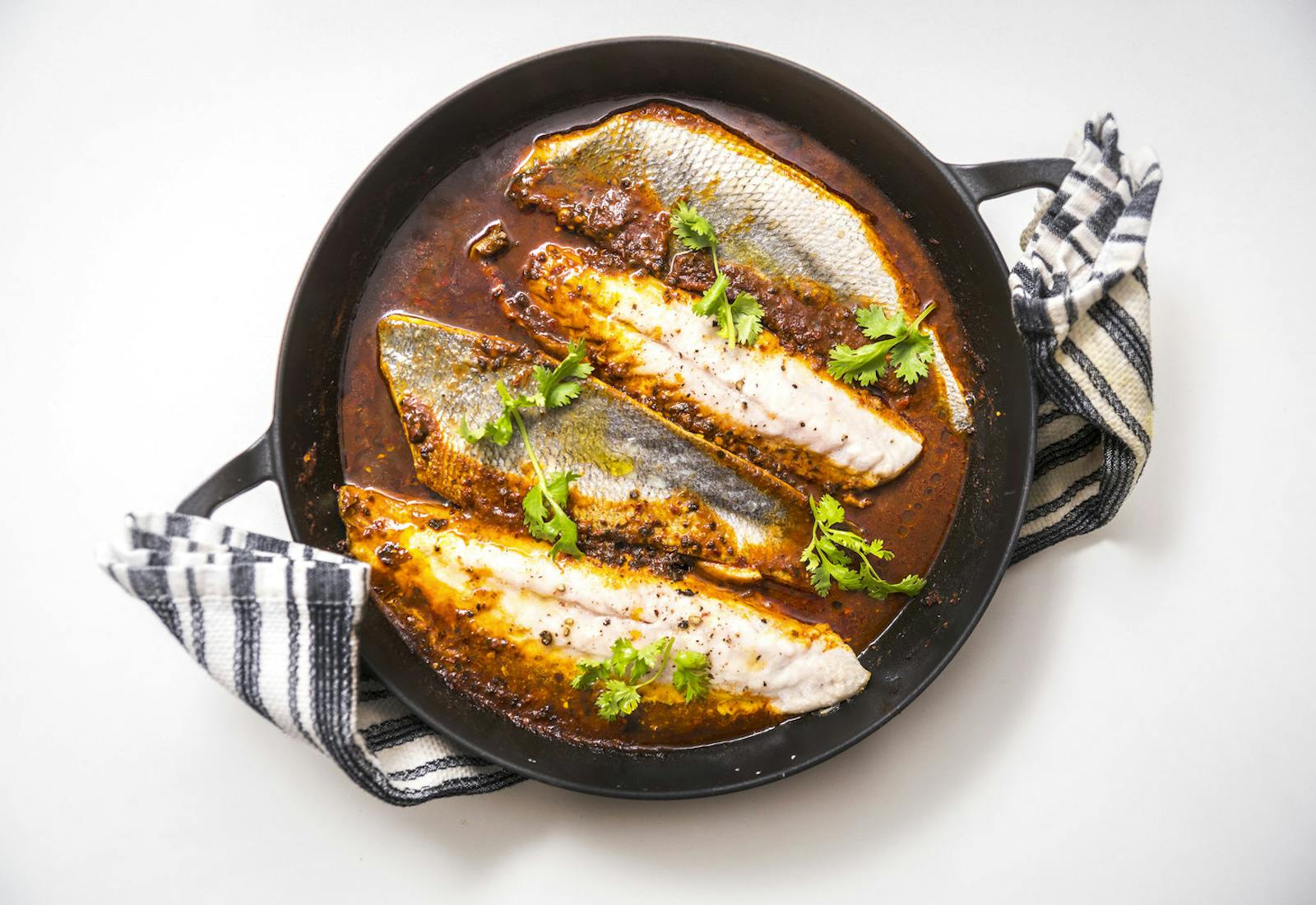
13. Chraime (Fish and Peppers Stewed in Spiced Tomato Sauce)
Yield: 4 servingsTime: 45minThis recipe was shared by Nir Feller. Read more about his family in "The North African Fish Recipe That Makes Chef Nir Feller Feel at Home."
Ingredients
For the Chraime base:
- 5 (~3oz.) dried ancho chiles
- 7 (~1.5 oz.) dried sweet paprika chiles
- 4-5 dried japones chiles
- 5 whole garlic cloves, peeled
- 2 medium tomatoes, cut in half
- 1 teaspoon ground cumin
- 3 teaspoons ground turmeric
- 6 tablespoons tomato paste
- 1 tablespoon salt
- ⅔ cup neutral oil like grapeseed, sunflower, or canola
- ½ cup water
For the Chraime:
- 4 boneless (~2 lbs.) skin-on fish fillets (a dense, firm white fish like mahi mahi, halibut, black cod, striped bass will work best)
- 6 tablespoons of chraime base
- 1 cup of water
For serving:
- Tahini
- Cilantro
- Challah
Preparation
Step 1
Preheat the oven to 425°. Lay the peppers out on a baking sheet and toast for about 1-2 minutes until they puff up a bit. Remove from the oven and let cool, then remove the stems and seeds.
Step 2
Place the tomatoes on a baking sheet and roast in the oven for 15-20 minutes, until they begin to caramelize and wrinkle.
Step 3
Place ⅓ of the chillies, the garlic, and the roasted tomatoes in a vitamix or a food processor and blend until uniform. Gradually mix in the rest of the chiles, cumin, turmeric, tomato paste, and oil until a smooth paste forms.
Step 4
Place a large skillet on the stove top over medium heat and add 6 tablespoons of the chraime base, heating for 1 minute. Add the water and bring to a gentle boil.
Step 5
Add the fish and let cook for about 6-8 minutes covered until fish is cooked through.
Step 6
Serve immediately with tahini, olive oil, a few leaves of cilantro and freshly baked challah bread.
Shared by Arielle (Nir) Mamiye and Efrat Navon
14. Hand-Rolled Couscous
Yield: 8 to 10 servingsTime: 1 h active + 4 h inactive + soakingShared by Arielle (Nir) Mamiye and Efrat Navon
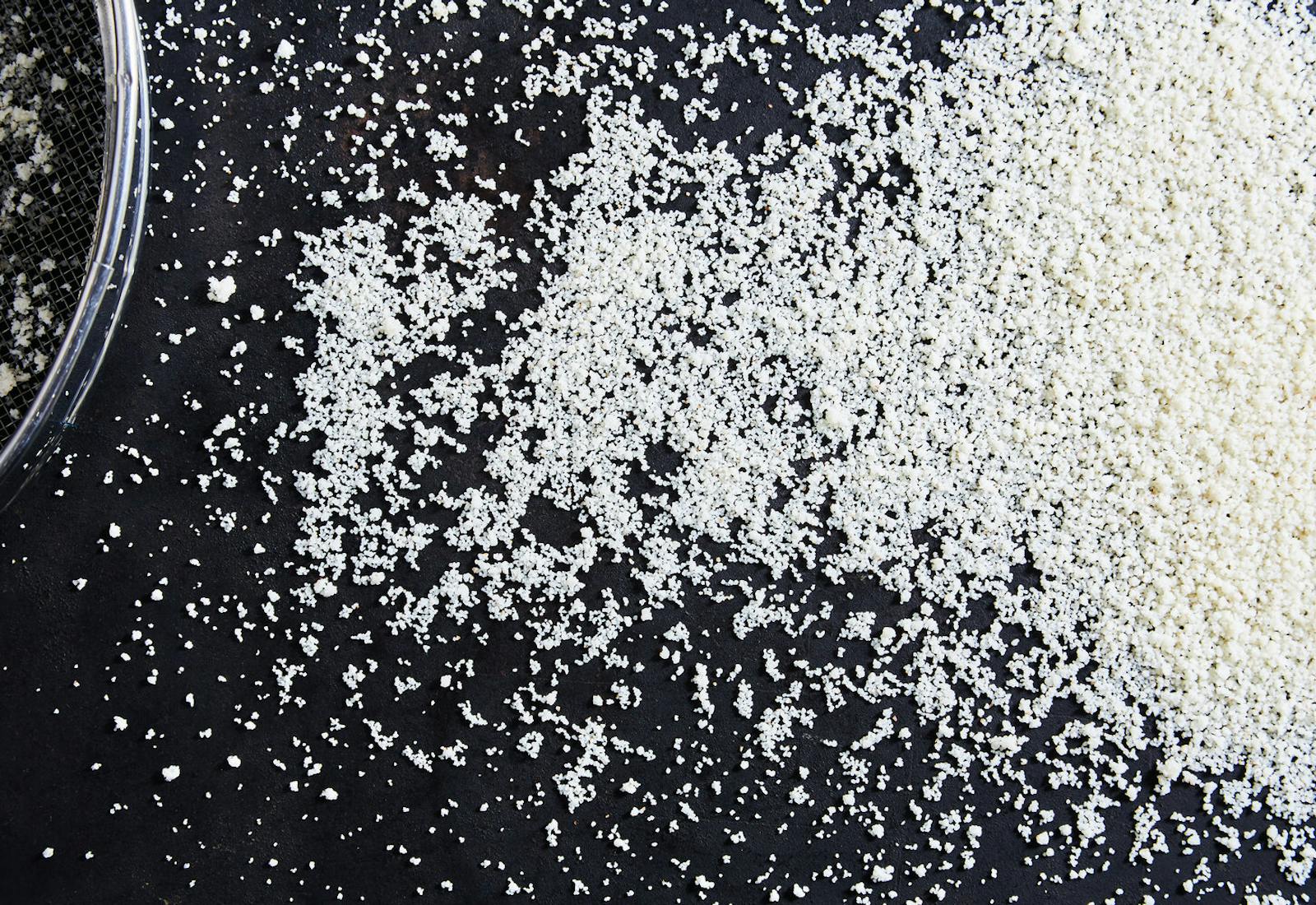
14. Hand-Rolled Couscous
Yield: 8 to 10 servingsTime: 1 h active + 4 h inactive + soakingThis recipe was shared by Arielle (Nir) Mamiye and Efrat Navon. Read more about their family in "A Moroccan Grandmother's Love Is Rolled Into Her Couscous" and try their recipe for rifat (Moroccan tea biscuits).
Ingredients
Special equipment
For the soup
- 1 cup dried chickpeas
- 1 ½ pounds chicken drumsticks and thighs, bone-in skin-on
- 1 ½ pounds pumpkin or butternut squash, deseeded and chopped into large pieces of about 3 x 2 inches
- 1 green cabbage, sliced into about 8 wedges
- 2 zucchinis, peeled with stripes and cut crosswise into 3 inch long pieces
- 2 carrots, peeled and cut crosswise into 3 inch pieces
- 3 celery stalks, chopped crosswise into 3 inch pieces
- 1 kohlrabi, peeled and chopped into quarters
- 1 bunch parsley, tied with butcher's twine
- 1 teaspoon ground turmeric
- 1 to 1 ½ tablespoons kosher salt
- ½ teaspoon ground white pepper
For the couscous
- 5 cups (2 pounds) semolina
- 1 tablespoon kosher salt
- 1 cup + 2 cups room temperature water, divided
- ½ cup vegetable oil
Preparation
Step 1
Place the chickpeas in a bowl and cover completely with room temperature water. Set aside to soak overnight, or for at least 8 hours.
Step 2
Strain the chickpeas from the soaking liquid and rinse with water. Place the chickpeas into a pot and cover with about 4 cups of water, or enough to completely submerge the chickpeas. Place the pot over high heat and bring to a boil. Reduce the heat to medium low and continue simmering the chickpeas for about 1 hour to 1 hour and 30 minutes until tender. Strain and set chickpeas aside. Discard the cooking liquid.
Step 3
Make the soup: Place the chickpeas into the bottom of the lower pot of the couscoussier. Add the chicken, pumpkin, cabbage, zucchinis, carrots, celery, and kohlrabi into the pot. Cover with water until the water reaches 1 inch below the top edge of the pot. Add parsley, turmeric, salt and pepper. Place the pot over high heat and bring to a boil, about 20 to 30 minutes. Reduce the heat to medium low and place a lid on the pot. Continue cooking the soup with a gentle simmer.
Step 4
Make the couscous: Place the semolina and kosher salt into an extra large mixing bowl. Mix with your fingers to combine. Set 1 cup of water and a seperate cup with ½ cup of oil to the side of the mixing bowl. Place your fingertips into the cup of water and sprinkle water droplets over the semolina and salt mixture, repeat again and sprinkle another round of water into the bowl. Start stirring the mixture with your hand, pressing down and moving the palm in a circular motion. Continue adding droplets of water, a few splashes at a time, and stirring with your hand until the water is well incorporated into the semolina mixture. It is better to add less water at a time to prevent any large clumps. At this point small to medium granules should form in the bowl. Using the same technique as the water, add the oil into the mixture a few droplets at a time, and stirring the mixture with the palm of your hand. After all the oil is incorporated there should be many medium sized granules. Place the sieve over another extra large bowl. Pour half of the semolina mixture into the sieve. Shake the sieve to sift out the semolina mixture into tiny granules. Use your palms to gently press the semolina mixture through the sieve in a circular motion until all the semolina has been sifted through. There may be some large clumps that will not pass the sieve, discard these lumps. Add the remaining semolina mixture into the sieve and repeat the sifting process, until all the mixture is passed through.
Step 5
Steam the couscous: Increase the heat of the soup to medium and make sure it is actively simmering. Remove the lid from the soup pot and add the steamer extension over the pot. Transfer the sifted semolina mixture into the steamer, poke about 6 holes through the semolina mixture with the back of a spoon to allow steam to enter. Place a lid over the couscoussier and steam the couscous for 45 minutes. Transfer the steamed couscous into an extra large mixing bowl and immediately pour 2 cups of room temperature water over the mixture. Use a fork to stir the mixture and set aside for 30 minutes. Stir the couscous with a fork every 10 minutes while it rests, about 2 times. This step ensures that the couscous will be tender at the end of the cooking process. Transfer the couscous back into the steamer and cover with a lid, no need to poke holes through the couscous this time. Cover with the lid and steam for another 20 minutes. Transfer the couscous into an extra large mixing bowl. Set aside. Remove soup from the heat, discard parsley, and set the pot aside. At this point the soup is ready after about 2 hours and 30 minutes of cooking. Let the couscous cool completely, for about 1 ½ hours, stirring with a fork occasionally, about 4 times. Once the couscous is completely cool, sift it through the sieve into an extra large bowl until all of the mixture is passed through and forms tiny couscous granules.
Step 6
About 20 minutes before serving, place the soup over medium to low heat and simmer to reheat. About 10 minutes before serving, transfer the couscous into the steamer and steam until warm, about 5 to 10 minutes.
Step 7
To serve, place a mound of couscous into a serving or individual bowl. Add vegetables and chicken from the soup on top of the couscous. Pour a few ladles of the soup over the bowl and serve hot.
Shared by Lior Lev Sercarz
15. P'kaila (Burnt Spinach, Bean, and Sausage Stew)
Yield: 6 - 8 servingsTime: 3-4 hoursShared by Lior Lev Sercarz
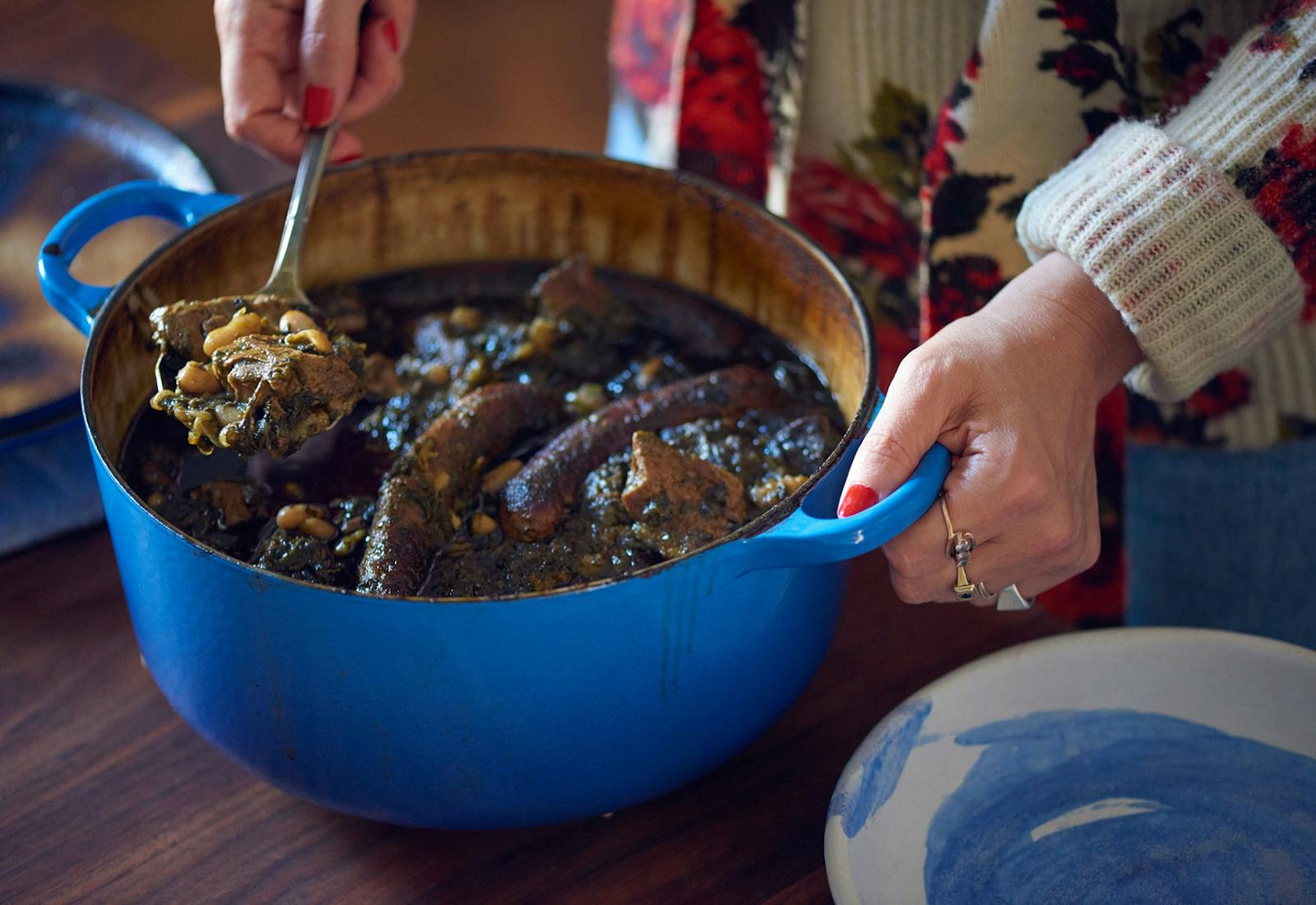
15. P'kaila (Burnt Spinach, Bean, and Sausage Stew)
Yield: 6 - 8 servingsTime: 3-4 hoursThis recipe was shared by Lior Lev Sercarz. Read more about his family in "How a Humble Tunisian Family Recipe Landed in One of New York’s Finest Restaurants."
Ingredients
- 1 cup extra virgin olive oil, divided
- 1 pound baby spinach, trimmed and washed
- 2 medium onions, thinly sliced
- 3 cloves garlic, sliced
- 1 tablespoon fresh thyme, coarsely chopped
- 2 cups cilantro, coarsely chopped
- 1 cup mint, coarsely chopped
- ½ teaspoon of cinnamon
- 2 tablespoons of ground cumin (or 1 tablespoon of La Boîte Tangier N.23)
- 2 tablespoons of ground coriander (or 1 ½ tablespoons of La Boîte Izak N.37)
- 1-2 tablespoons of harissa (depending on how spicy you like it)
- 2 cups of white beans (cannellini, great northern, navy, etc.), soaked overnight
- 3 1 ½ “ thick pieces of bone marrow (optional)
- 1 ½ pounds lamb or beef stew meat, cut into 1” cubes
- ½ pound merguez sausage, whole
- kosher salt
Preparation
Step 1
Preheat the oven to 300°.
Step 2
In a large heavy-bottomed pot, heat a ½ cup of the olive oil over medium-high heat until smoking (something with a light enamel bottom is good here so that you can see the color of the spinach and oil change). Add the spinach and sauté, stirring frequently with a wooden spoon. Continue to cook, scraping the bottom of the pot with your wooden spoon frequently, until all of the water evaporates and the spinach is blackened. The entire process will take around 35 minutes. As the spinach cooks, add two more rounds of a ¼ cup of olive oil (at about 10 and 25 minutes into the process) when the spinach starts to get overly dry and sticky. The spinach is done when it’s dark and crispy, almost black and the residual oil is a deep green. At this point you can freeze the spinach and use it to make the pkaila later.
Step 3
Remove the spinach from the pot with a slotted spoon, leaving the oil from the spinach in the pot. Add the onions and a ½ teaspoon of salt and sauté until softened, about 5 minutes.
Step 4
Turn the heat to low. Add the blackened spinach, garlic, thyme, cilantro, mint, cinnamon, cumin, coriander, harissa, and beans and stir to combine evenly.
Step 5
Create little pockets in the mixture and plug the bone marrow in (if using). Add the lamb or beef and the sausage to the pot and cover with water or stock (about 6 cups).
Step 6
Bring to a simmer, cover and place in the oven. Cook for 2-3 hours, checking occasionally and adding more water or stock if needed, until the beans and lamb or beef is tender. Season to taste and serve immediately.
Shared by Simone and Marc Azoulay and Marie Salomé Peyronnel
16. Boulettes à l'oignon (Meatballs with Onion)
Yield: 6-8 servingsTime: 1 H 30 minShared by Simone and Marc Azoulay and Marie Salomé Peyronnel
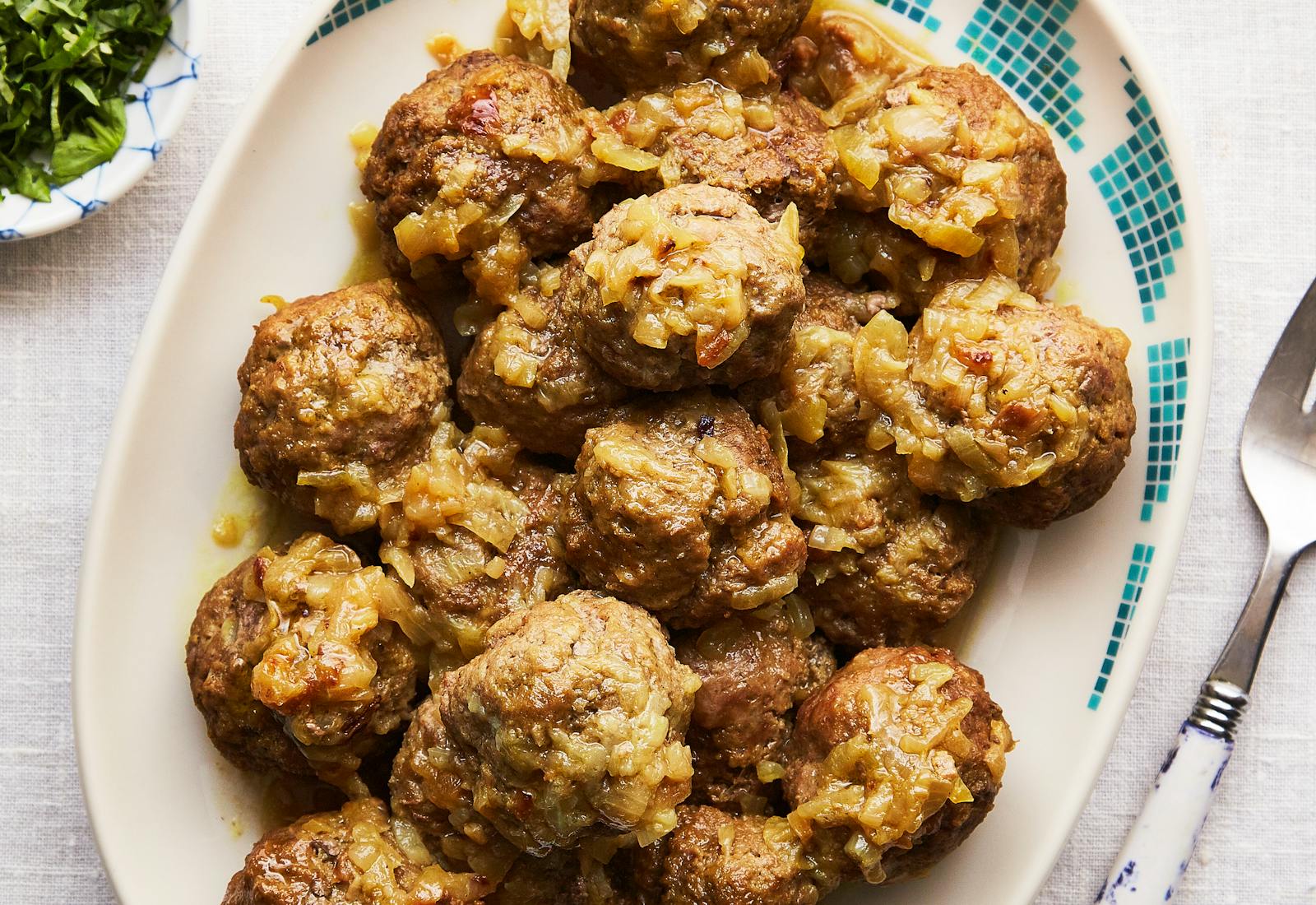
16. Boulettes à l'oignon (Meatballs with Onion)
Yield: 6-8 servingsTime: 1 H 30 minGround potatoes help fill out these meatballs, which Simone Azoula serves for Shabbat. Since her recipe calls for matzo meal, instead of flour, you can also make these during Passover.
Read more about her family’s Shabbat in “Whether in Paris, New York, or Beyond, Marc Azoulay Always Makes Time for Shabbat Dinner” and try her recipes for chicken with olives and saffron, fish patties simmered in tomato sauce, cooked Moroccan salad of tomatoes and peppers, and cumin-laced beets.
Ingredients
For the meatlballs:
- 1 yellow onion, roughly chopped
- 1 medium russet potato
- 3 lbs ground beef
- 2 teaspoons salt
- 1 teaspoon white pepper
- 1 teaspoon nutmeg
- 1 ¼ teaspoon mace
- ¼ cup + 2 tablespoons matzo meal
- 2 tablespoons sunflower oil
For the onion sauce:
- ¼ cup sunflower oil
- 2 yellow onions, halved and thinly sliced
- 1 teaspoon salt
- ¾ teaspoon white pepper
- 1 teaspoon turmeric
Preparation
Step 1
In a blender pulse the chopped onion and potato until it is completely smooth.
Step 2
In a large bowl mix the beef, potato-onion mixture, 2 teaspoons salt, 1 teaspoon white pepper, nutmeg, mace, matzo meal, 2 tablespoons sunflower oil and 1 cup water. Set aside and allow the flavors to meld.
Step 3
In a wide heavy-bottomed pot, heat ¼ cup oil over low heat. Place the thinly sliced onion into the pan and cover, allowing to soften until they are soft and golden, about 15 minutes. Add 3 cups water, 1 teaspoon salt, ¾ teaspoon white pepper and turmeric. Bring the mixture to a boil then reduce the heat and allow to simmer, covered for about 30 minutes.
Step 4
With oiled hands, shape about 30 balls, about 70 grams each. The mixture will be very soft, so handle it lightly.
Step 5
Place the meatballs into the simmering sauce, cover and cook for approximately 30 minutes. If you don’t have a pot large enough to fit all the balls in one layer, do this step in batches: Place half the meatballs into the simmering sauce and cook for 10 minutes. Remove and place the rest of the meatballs into the pot, cook for 10 minutes. Then return the rest of the partially cooked meatballs (it’s okay if they’re crowded now) to the pot and continue cooking for another 20 minutes.
Shared by Simone and Marc Azoulay and Marie Salomé Peyronnel
17. Poulet aux Olives (Chicken with Olives)
Yield: 6-8 servingsTime: 45 min + 40 min inactiveShared by Simone and Marc Azoulay and Marie Salomé Peyronnel
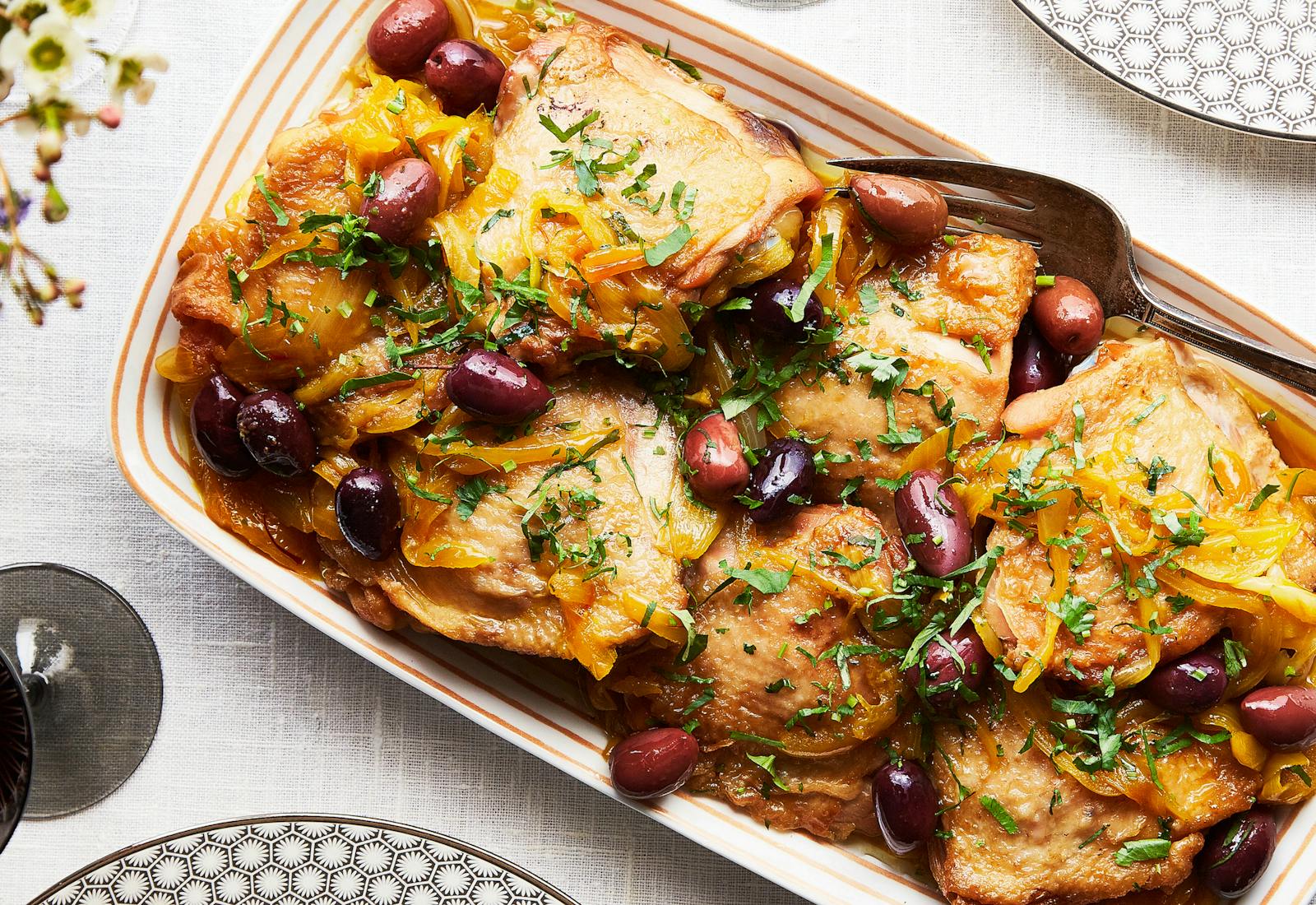
17. Poulet aux Olives (Chicken with Olives)
Yield: 6-8 servingsTime: 45 min + 40 min inactiveAt Simone Azoulay’s home in Paris, the Shabbat menu is always changing, but “Our tradition is to have one fish and one meat dish,” her son Marc explains. You can serve this chicken braised with olives, ginger, and saffron, after Marie’s poisson à la Marocaine, fish patties in a tomato sauce, or not, it’s wonderful either way.
Read more about their family’s Shabbat dinners in “Whether in Paris, New York, or Beyond, Marc Azoulay Always Makes Time for Shabbat Dinner” and try Simone’s recipes for meatballs with onions, a cooked Moroccan salad of tomatoes and peppers, and cumin-laced beets.
Ingredients
- 3 tablespoons olive oil
- 6 lbs chicken thighs, dried with paper towels
- 2 onions, halved and thinly sliced
- ¾ teaspoons salt
- ½ teaspoon pepper
- 2 cloves garlic, minced
- 30 straws saffron, bloomed in 1 cup warm water
- Juice of 1 lemon
- 1 ½ inch knob of ginger, grated
- 1 bunch cilantro leaves, chopped
- 2 pints whole black kalamata olives, rinsed
Preparation
Step 1
Heat the olive oil in a large heavy-bottomed pot over medium heat. Sear the chicken thighs, placing them skin-side down for 3-5 minutes then flipping to brown for another 3 minutes. Remove the thighs and set aside on a large platter. You will have to do this in batches.
Step 2
In the same pot you seared the chicken in, lower the heat to medium-low and add the onion. Mix with a rubber spatula, scraping up any chicken fat that has stuck to the bottom. Cover and allow to soften for 5-7 minutes.
Step 3
Uncover and add the salt, pepper, minced garlic, saffron water, lemon juice, grated ginger, cilantro and olives. Mix to incorporate and cook for another 5 minutes. Remove half of the sauce and set aside in a bowl.
Step 4
Layer the chicken and the sauce that has been set aside in the pot then pour ¾ cups water. Cover and cook over medium-low heat for approximately 40 minutes.
Shared by Kathy Berrie
18. Pastela (Layered Beef, Potato, and Egg Casserole)
Yield: 10 servingsTime: 2h plus 50min baking timeShared by Kathy Berrie
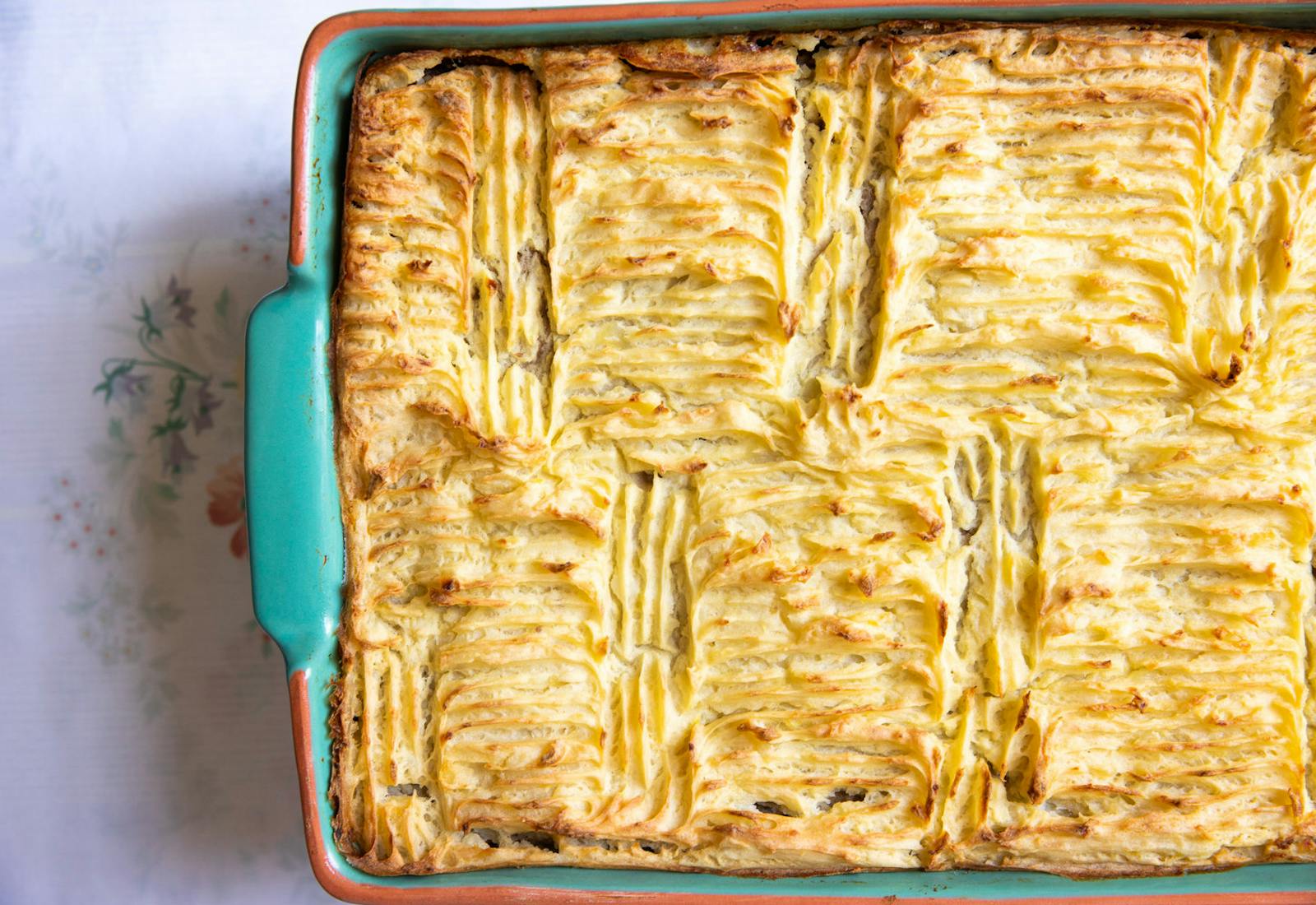
18. Pastela (Layered Beef, Potato, and Egg Casserole)
Yield: 10 servingsTime: 2h plus 50min baking timeThis recipe was shared by Kathy Berrie. Read more about her family in "Memories of Morocco: Pastela + Tomato Salad" and try her recipe for tomato salad with capers.
Ingredients
- 1 gram saffron threads (roughly 1 tablespoon)
- 3 ½ cups boiling water
- 3 pounds ground beef
- 1 onion, coarsely chopped
- 1 cup lightly packed parsley leaves
- 1 teaspoon nutmeg
- 1 ¼ teaspoon mace
- 1 tablespoon salt
- 1 teaspoon pepper
- 1 tablespoon vegetable oil
- 1 cup red wine vinegar
- ¾ cup fresh squeezed lemon juice
- 15 medium red and yellow potatoes, peeled
- 6 large eggs
- 6 large eggs, hard boiled, cut in half lengthwise
Preparation
Step 1
Place the saffron threads in a quart size jar that has a lid. Pour the boiling water over the threads and let cool. Cover and store until ready to use.
Step 2
Place the beef, onion, and parsley in a medium heavy bottomed pot and mix to combine. Add the nutmeg, mace, salt, pepper, vegetable oil and a ½ cup of the cooled saffron water. Cover and cook over medium heat for 1 hour.
Step 3
Stir in the red wine vinegar and the lemon juice. Cover and cook for 10 minutes. Uncover, taste and adjust for salt. Cook uncovered until all of the liquid has evaporated from the pot, about 20 more minutes.
Step 4
Meanwhile, place the potatoes in a large pot and cover with an inch of water. Boil the potatoes until fork tender, about 15-20 minutes. Drain the potatoes, place them back in the pot and return them to the stove. Place over low heat for about 10 minutes until all excess moisture is released.
Step 5
Let the meat cool, then pulse in a food processor for about 10 seconds until coarse and fluffy.
Step 6
In a large bowl, beat the potatoes with a hand mixer or hand blender until combined. Add 3 eggs and continue blending. Add 3 more eggs and salt to taste and continue blending until potatoes are light and fluffy.
Step 7
Preheat the oven to 350°.
Step 8
To assemble: grease a 9x13 inch baking dish. Coat your hands lightly with oil and layer the bottom of the baking dish evenly with a ½ inch thick layer of potato. Next, take a handful of the meat mixture and flatten it out on your palm. Place the flattened meat on top of the potato layer. Continue creating small flat patties in the palm of your hand and unifying them as one layer over the potatoes. Place the hard boiled eggs yolk down in a pattern of your choosing on top of the meat layer. Cover the eggs with another ½ inch thick layer of potatoes (oiling your hands again to prevent the potato from sticking). To the potato layer, add a last layer of the ground meat. Top the final meat layer with a layer of potato. Using a fork, create a pattern in the top layer of potato by drawing horizontal and vertical lines and making a design.
Step 9
Bake for 50 minutes until golden on top.
Shared by Kathy Berrie
19. Saffron-Lemon Chicken
Yield: 6-8 servingsTime: 2h 15minShared by Kathy Berrie
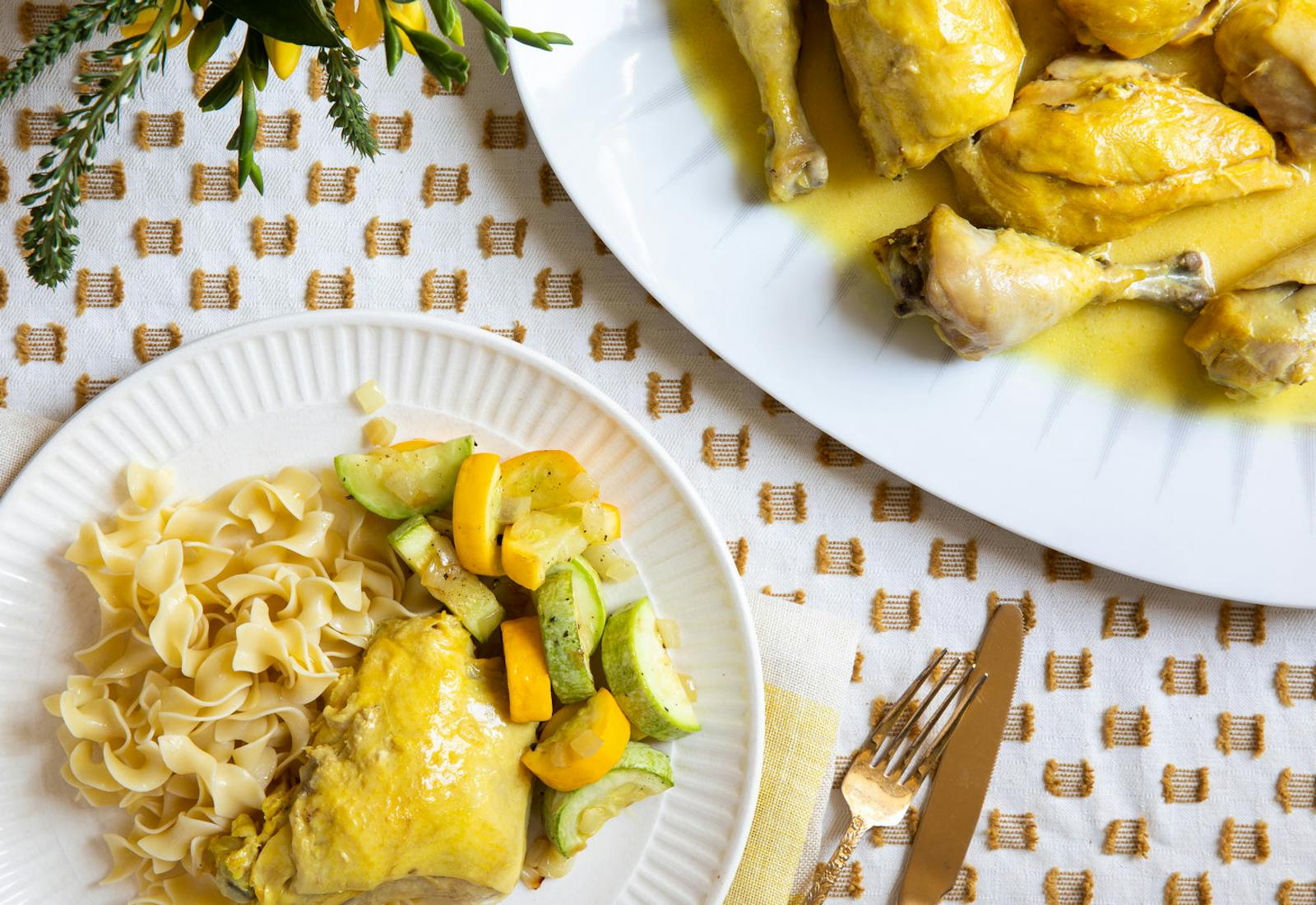
19. Saffron-Lemon Chicken
Yield: 6-8 servingsTime: 2h 15minThis recipe is featured in our cookbook "The Jewish Holiday Table: A World of Recipes, Traditions & Stories to Celebrate All Year Long." For more holiday recipes from around the world, get your copy!
This recipe was shared by Kathy Berrie. Read more about her family in "A Moroccan Lemon Chicken That Marks the Start of the Fast."
Ingredients
For the chicken:
- About 1 ½ teaspoons saffron threads
- 1 ½ cups boiling water
- One (4 ½ pound) chicken, cut into 6-8 pieces, or 6-8 chicken pieces--bone-in breasts, thighs, and/or drumsticks
- Kosher salt
- 3 tablespoons vegetable oil
- 1 head of garlic, cloves separated and peeled
- 5 large egg yolks
- ⅔ cup fresh lemon juice (from about 4 lemons), or more to taste
For serving:
- 1 pound wide egg noodles
- Finely chopped fresh flat-leaf parsley (optional)
Preparation
Step 1
Prepare the chicken: Put the saffron threads in a small bowl and pour the boiling water over them. Let cool, stirring once or twice, then set aside.
Step 2
Season the chicken pieces generously with salt.
Step 3
Heat the oil in a large heavy-bottomed skillet or Dutch oven over medium heat. Add the chicken and cook, turning occasionally, until the pieces are nicely browned on all sides, 10-15 minutes. (You may need to do this in batches to avoid crowding the skillet.)
Step 4
Add the garlic and saffron water to the pan, cover, and adjust the heat to a low simmer. Cook the chicken until it's very tender, almost falling off the bone, 1 to 1 ½ hours. Remove the skillet from the heat and let the chicken cool for about 15 minutes.
Step 5
Meanwhile, bring a large pot of water to a boil, season well with salt, cover the pot, and then reduce the heat slightly so the water stays hot and almost ready to cook the noodles once the chicken is finished.
Step 6
In a small bowl, whisk together the egg yolks and lemon juice until well blended.
Step 7
Pour the egg and lemon mixture into the chicken cooking liquid. Lift the pan and swirl several times until the sauce comes together and is blended.
Step 8
Return the skillet to low heat and cook gently, swirling the pan or stirring with a silicone spatula, until the sauce reaches 175°F and thickens slightly. You can test for doneness by dipping a large spoon in the sauce and running your finger across the coated spoon; if your finger leaves a clear track that doesn't instantly run back together, the sauce is ready. Taste the sauce and adjust the flavors with more salt and lemon juice if necessary; keep warm while you cook the noodles.
Step 9
Bring the pot of salted water back to a boil. Add the egg noodles and cook according to the package instructions. Drain well.
Step 10
Serve the chicken with the egg noodles, ladling the sauce and garlic cloves over the chicken. Sprinkle with parsley, if using.
Shared by Nitza Kardish
20. Ma'akud (Libyan Potato Casserole With Beef and Vegetables)
Yield: 4 - 8 servingsTime: 1hShared by Nitza Kardish
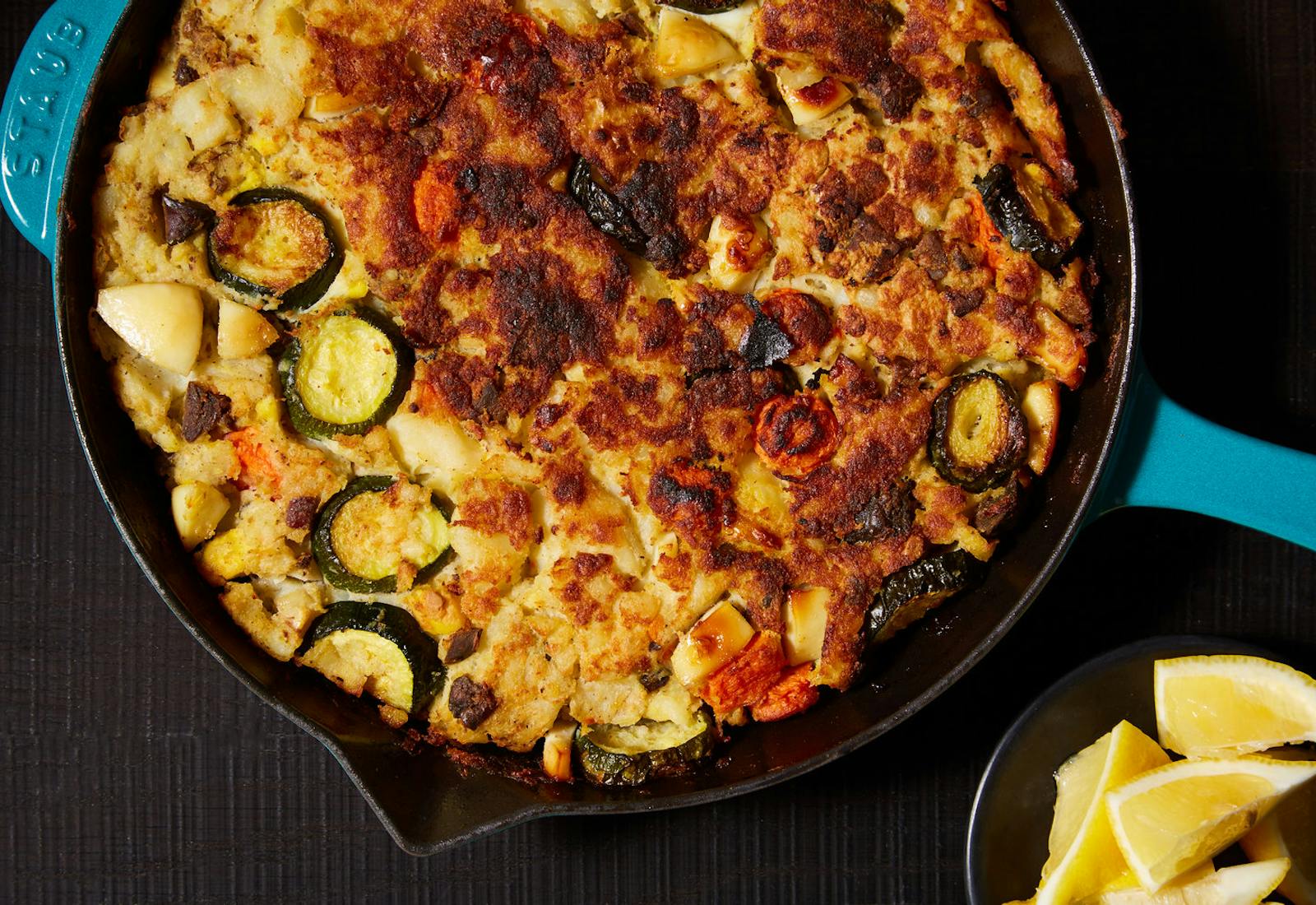
20. Ma'akud (Libyan Potato Casserole With Beef and Vegetables)
Yield: 4 - 8 servingsTime: 1hThis recipe was shared by Nitza Kardish. Read more about her family in "A Libyan Shakshuka That Will Never Change" and try her recipes for sesame seed rolls, and Libyan shakshuka.
Ingredients
- 4 Large potatoes, peeled and cut into large chunks
- 2 carrots, peeled and sliced into ¼” rounds
- 1 medium zucchini, peeled and sliced into half moons
- 1 tablespoon olive oil
- ½ lb. ground beef
- 2 eggs, hard-boiled, coarsely chopped
- 2 eggs
- ¼ teaspoon nutmeg
- A pinch of cinnamon
- 2 ½ teaspoons kosher salt
- ½ teaspoon black pepper
- ¼ cup vegetable oil
- 1 lemon, for serving
Preparation
Step 1
Place the potatoes in a large pot and cover with cold water. Bring to a boil, then lower heat to a gentle simmer and cook until tender, 15-20 minutes. Drain and set aside to cool.
Step 2
While the potatoes cook, bring a medium pot of well salted water to a boil. Add the carrots and cook, until just tender, about 10 minutes. Using a slotted spoon or spider, remove them from the water and set aside. Add the zucchini, and cook until just tender, about 5 minutes, then drain and add to the carrots.
Step 3
Heat the oil in a skillet over medium heat. Add the ground beef, sprinkle with ½ teaspoon of salt and ¼ teaspoon of black pepper. Sauté, using a wooden spoon to break the meat up into little pieces as it cooks, until no longer pink, about 5 minutes. Remove from heat and set aside.
Step 4
Preheat the oven to 375°F.
Step 5
Place the potatoes in a large bowl and mash with a potato masher or the back of a fork. Add the carrots, zucchini, ground beef, hard boiled eggs, regular eggs, nutmeg, cinnamon, remaining 2 teaspoons of salt, and remaining ¼ teaspoon of pepper. Mix well until evenly combined.
Step 6
Heat the vegetable oil in a medium sized pan that can go into the oven. Transfer the potato mixture from the bowl into the pan and flatten well to fill the pan.
Step 7
Cook on medium-high for 10 minutes until stable and browned on the bottom. Take a large plate, place it on the rim of the pan, and using potholders, turn the pan upside down to invert the Ma’akud onto the plate. Then, gently slide the turned Ma’akud back into the pan, browned side up.
Step 8
Bake in the oven for an additional 30-45 minutes until cooked through and browned.
Step 9
Let rest for 5 minutes, then slice into triangles and serve with a wedge of lemon.
Shared by Ori Menashe
21. Beef Cheek Tagine
Yield: 2-4 servingsShared by Ori Menashe
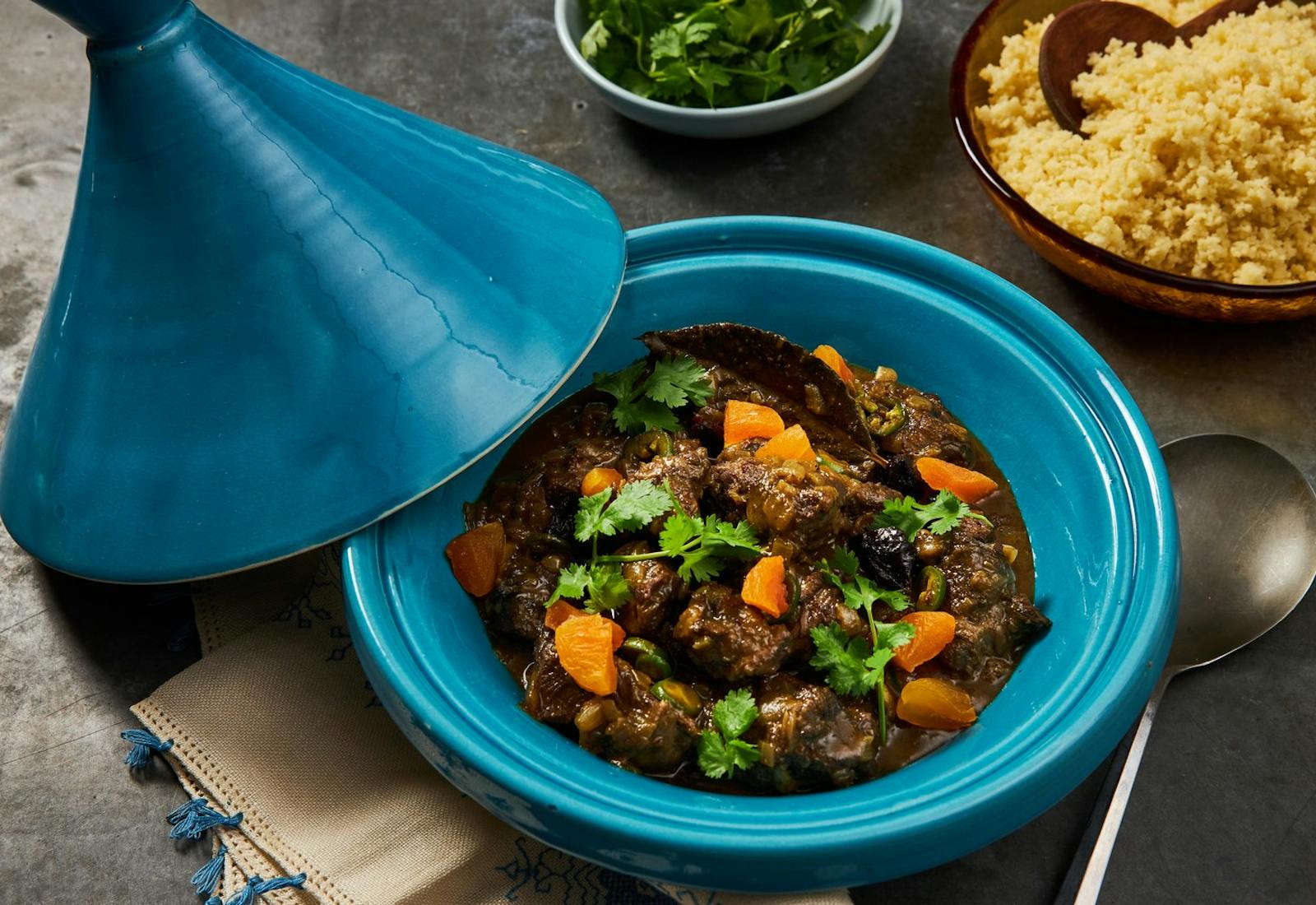
21. Beef Cheek Tagine
Yield: 2-4 servingsThe cheeks can be prepared up to 1 day ahead and stored, covered, in the refrigerator overnight. To reheat, preheat the oven to 325°F. Remove the beef cheeks from the refrigerator and skim the fat off the top. Cook for about 30 minutes, until the dish reaches your desired temperature.
Ingredients
- 2 ¼ pounds beef cheek, cleaned and cubed into 1 ¼ inch pieces (may substitute beef short rib)
- 1 tablespoon plus 1 teaspoon kosher salt
- ½ teaspoon freshly ground black pepper
- 2 ¼ teaspoons granulated sugar
- 1 ½ cups apple cider vinegar
- 2-inch piece fresh ginger, peeled
- 2 garlic cloves
- 1 quart Super Stock (see separate recipe below); may substitute high-quality store-bought vegetable stock
- infused with the aromatics from the super stock recipe
- 2 tablespoons unsalted butter
- 3 cups diced yellow onion (3 onions)
- 1 fresh bay leaf or 1 dry bay leaf
- 3 tablespoons Ras el Hanout
- 1 tablespoon brown sugar
- 1 serrano chile, sliced
- 1 prune, quartered
- 4 dried apricots, quartered
- Cilantro leaves and stems for garnish
- Rice, couscous, or mashed potatoes for serving
Preparation
Step 1
Season the beef cheek with salt, black pepper, and granulated sugar. Let rest for 10 minutes. In a blender, puree the vinegar, ginger, and garlic.
Step 2
Place the seasoned beef cheeks in a bowl, pour the liquid over the meat, and mix to coat. Cover with plastic wrap and let marinate in the refrigerator overnight or for up to 24 hours.
Step 3
Remove the beef cheeks from the refrigerator. Drain, reserving the liquid, and bring to room temperature. Transfer the reserved marinade to a small saucepan and cook over low heat until reduced by half. Set aside.
Step 4
In a separate small saucepan, bring the stock to a boil. Preheat the oven to 325°F. Add 1 tablespoon of the oil and ½ tablespoon of the butter to a sauté pan and place over high heat. Add one-quarter of the meat and sear on both sides until golden, about 4 minutes, then transfer to a plate with a slotted spoon and set aside. Repeat this process, adding another 1 tablespoon of the oil and ½ tablespoon of the butter to the pan before adding another one-quarter of the meat, until all the meat has been seared.
Step 5
Wipe the pan clean, then return to the stove over high heat and add the remaining 3 tablespoons of oil. Add the onion and bay leaf and cook for 4 to 5 minutes, until the onion is translucent, stirring to avoid browning. Remove the pan from the heat and add the ras el hanout. Stir to coat the onions and bloom the spices for about 1 minute. Add the brown sugar and the reduced marinade liquid and stir to combine.
Step 6
Transfer the onion mixture to a 6-quart baking dish and top with the seared beef cheeks. Pour the hot stock over the beef cheeks. Then cover the dish with aluminum foil. Bake for 2 ½ hours, until the meat is fork-tender and has fully broken down. Remove the cheeks from the oven and uncover. Add the sliced serrano chile and let rest, uncovered, for 1 hour.
Step 7
To serve, transfer the cheeks to a large serving bowl or tagine and top with the prune and apricots. Garnish with cilantro leaves. Serve with a side of rice, couscous, or mashed potatoes.
Shared by Michel Thouati
22. Asada de Cordero con Alcachofas (Braised Lamb Shoulder With Artichokes)
Yield: 8 servingsTime: 1 h active + 7 h inactiveShared by Michel Thouati
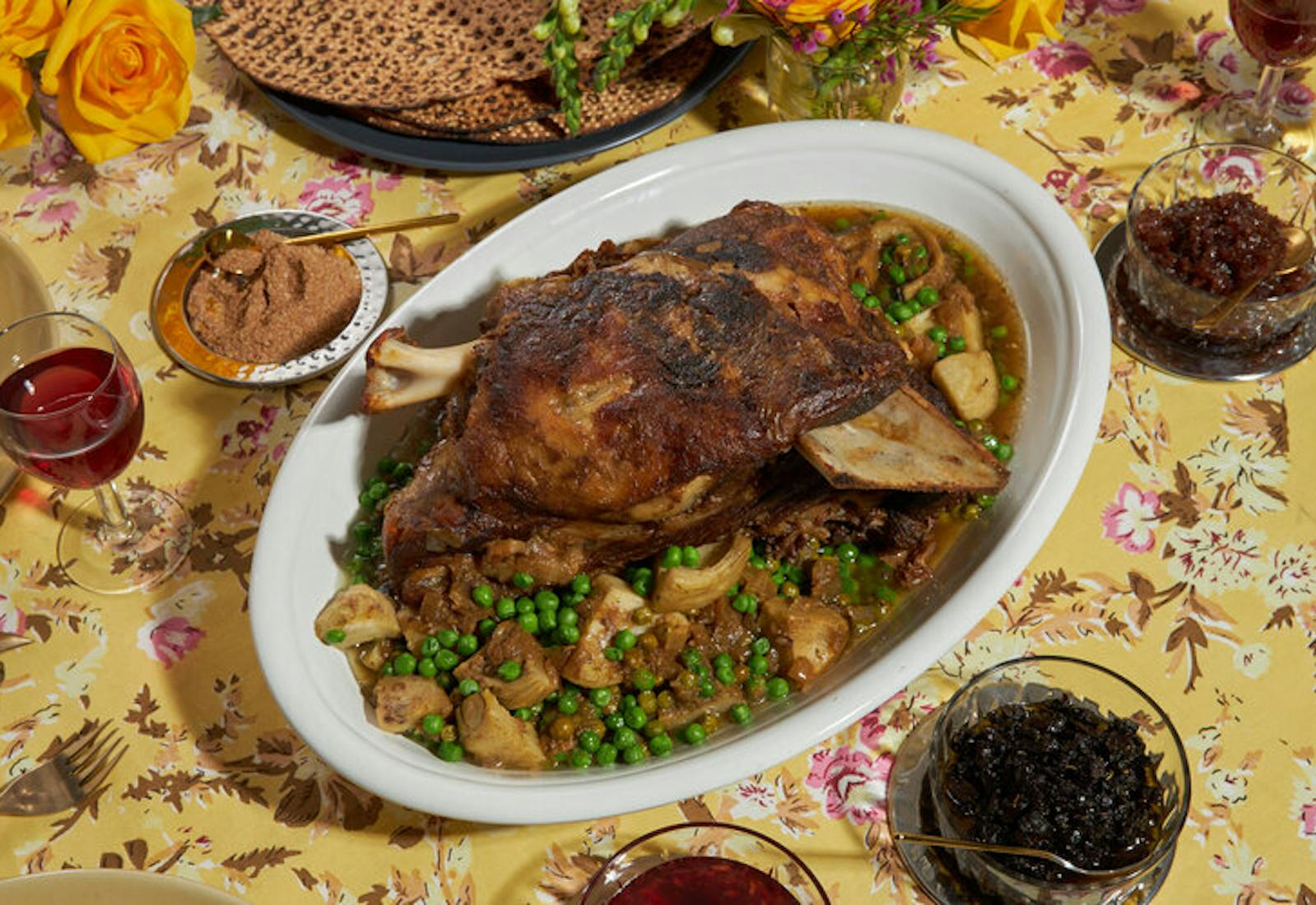
22. Asada de Cordero con Alcachofas (Braised Lamb Shoulder With Artichokes)
Yield: 8 servingsTime: 1 h active + 7 h inactiveMichel Thouati had this dish many times when he was a child but as he moved away, it faded from his life. In his early 30s, he tried to reproduce the flavor he remembered, but it wasn’t easy. It took 15 years of experimenting before he matched the taste of the family recipe.
Read more about Michel's family in "Preserving a Five-Century Long Link to Andalusia at Passover and Beyond" and his recipes for Orange and Olive Salad, Carrilleras Asadas en Lancha de Matsa (Braised Beef Cheeks), and Guizadas de Pessah (Passover Almond Macaroons).
Ingredients
- 1 jar of pomegranate jam
For the lamb
- 3 teaspoons ground cumin
- 4 teaspoons salt
- 2 teaspoons garlic powder
- 4 tablespoons olive oil
- 4-6 pounds bone in lamb shoulder
- 2 large yellow onions, chopped into a medium dice
- 8 cloves garlic, minced
- 2 teaspoons sugar
- 1 teaspoon fresh or dry thyme leaves
- 48-60 ounces young sweet peas (frozen or canned), defrosted if frozen
- 28 ounces frozen artichoke bottoms, defrosted and cut into quarters crosswise
- 2 tablespoons honey
- Juice and zest of one lemon
For serving
- For the spice mix:
- 1 tablespoon ground cumin
- 1 tablespoon garlic powder
- 1 tablespoon salt
- ½ teaspoon lemon zest
- 1 teaspoon Ceylon cinnamon or regular cinnamon
For the chopped olives
- 40 salt cured black olives, pitted, roughly chopped
- 2 tablespoons olive oil
- ⅛ teaspoon dried thyme
- ⅛ teaspoon dried oregano
- ⅛ teaspoon dried rosemary
For the confit red onions in vinegar
- 4 tablespoons olive oil
- 3 tablespoons light brown/turbinado sugar
- 2 medium red onions, chopped into a medium dice
- ½ teaspoon ground black pepper
- 1 large star anise
- 3 tablespoons sherry vinegar
Preparation
Step 1
Preheat the oven to 250 degrees.
Step 2
Mix the cumin, 3 teaspoons of salt, and garlic in a small bowl and rub this mixture all over the lamb shoulder.
Step 3
Place a 10 quart dutch oven with 2 tablespoons of olive oil over medium to medium high heat. Once the oil is hot, add the lamb shoulder and sear on all sides until golden brown, about 5 minutes per side. Transfer to a plate. Add the 2 remaining tablespoons of olive oil and add the chopped onions.Saute until the onions are golden brown. Add the garlic and saute for 2 more minutes until softened. Add the sugar, 1 teaspoon salt, and thyme and stir. Add the lamb back into the pot and add 4 tablespoons of water. Place a lid on the pot and bring the liquid to a simmer. Transfer the pot into the oven and cook for 5 hours.
Step 4
Take the pot out of the oven and stir very gently. Add the peas, artichoke bottoms, honey, lemon juice and lemon zest and mix very gently. Cover with the lid and cook for another 45 minutes to 1 hour until the vegetables are cooked through and the lamb is extremely tender. If there is too much juice/sauce in the pot, transfer the lamb onto a plate. Increase the oven to 450 degrees and broil the juices uncovered for 10 minutes until reduced.
Step 5
Make the spice mix: Mix the cumin, garlic powder, salt, lemon zest and cinnamon in a small bowl.
Step 6
Make the chopped olives: Mix the chopped olives with oil, thyme, oregano and rosemary in a bowl until combined well.
Step 7
Make the confit red onion in vinegar: Heat the olive oil in a 12" frying pan over medium heat. Add the sugar into the oil and stir nonstop for about 7 minutes, until it becomes amber colored. Add the onions in 3 equal batches, mixing after each addition. Add the black pepper and star anise and saute until the onions are golden brown and tender. Add the vinegar and saute for 3 more minutes. Lower the heat to medium low and cook the mixture down until the flavors have nicely mellowed, about 20 to 30 minutes. Remove the star anise, let cool for 15 minutes and serve warm.
Step 8
To serve, plate the vegetables that have been cooking with the lamb on the bottom of a serving platter. Gently place the cooked lamb on top. Pour the cooking juices over the lamb and vegetables. Serve hot. Serve the spice mix, chopped olives, confit red onions and pomegranate jam on the side and add these topping onto each individual portion of the lamb.
Shared by Nitza Kardish
23. Mafrum (Libyan Stuffed Vegetables)
Yield: 6 - 8 servingsTime: 2h 30min plus 1h cooking timeShared by Nitza Kardish
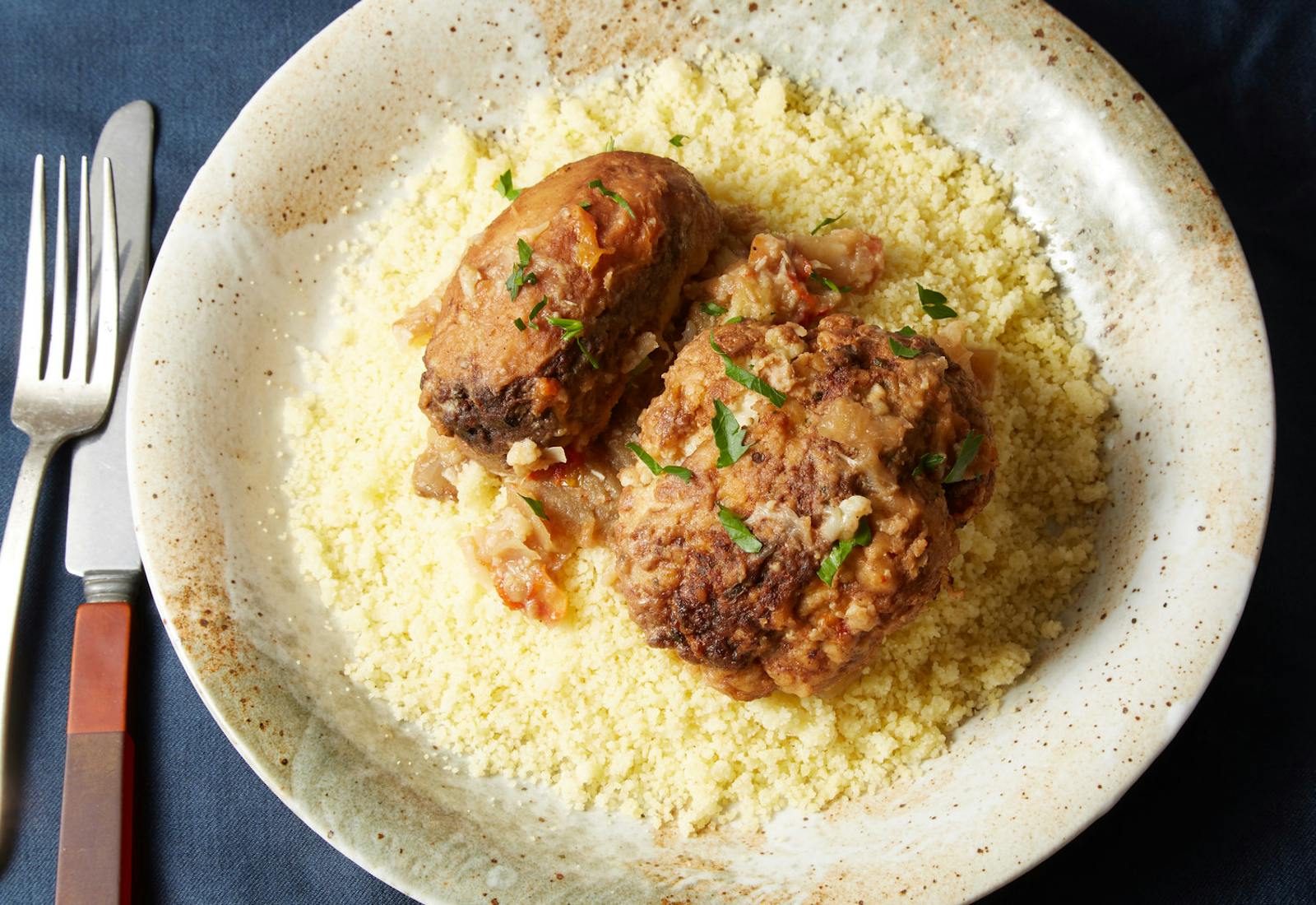
23. Mafrum (Libyan Stuffed Vegetables)
Yield: 6 - 8 servingsTime: 2h 30min plus 1h cooking timeThis recipe was shared by Nitza Kardish. Read more about her family in "Keeping a Libyan Tradition Alive in Israel" and try her recipe for Libyan tea with peanuts fennel and kohlrabi.
Ingredients
For the sauce:
- 3 tablespoons neutral oil (like canola, grapeseed, or safflower)
- 2 medium onions, coarsely chopped
- 2 medium vine ripe tomatoes, cut into wedges
- 1 small zucchini, peeled and cut into chunks
- 1 red bell pepper, cut into chunks
- 5-6 cloves of garlic, peeled and crushed
- 1 cup water
- 2 teaspoons Ras El Hanout
*The onion and tomato are musts, for the rest of the vegetables you can use whatever you have on hand. You want to create a bed for the mafrum that fills the bottom of the pan. You can also add the scraps from the potato and eggplant as you are making and stuffing the mafrum.
For the mafrum
- 4 medium russet potatoes, peeled
- 1 medium eggplant, peeled
- Kosher salt
For the filling:
- 2 medium onions, roughly chopped
- 6 cloves of garlic, roughly chopped
- ⅓ bunch cilantro, washed, leaves and tender stems only
- ½ bunch parsley, washed, leaves and tender stems only
- 1 lb. ground beef, 80% lean (use beef with at least 15% fat)
- 1 egg
- 1 ½ teaspoons Ras El Hanout
- 1 ½ teaspoons salt
- ¼ teaspoon black pepper
- ¼ cup plain breadcrumbs (not always necessary)
For frying:
- 3-4 cups all-purpose flour, for dusting
- ¾ cup water
- 1 egg
- ¼ cup tomato paste
- 1-2 quarts canola oil
Preparation
Step 1
In a large, deep pan (a 4 qt. braiser works well), heat the oil over medium-high heat. Add the onion, tomatoes, zucchini, bell pepper, and garlic and sauté until onion is translucent, about 5 minutes. Add the water and Ras El Hanout and stir to combine. Cover and cook over medium-low heat while you prepare the Mafrum.
Step 2
Place 2 tablespoons of kosher salt in a large bowl. Dissolve the salt in ½ cup of hot water and then fill with cold water. Place the peeled potatoes in the salt water to soak for about 25 minutes (it will help the potatoes stay together when stuffing them later).
Step 3
Shape the eggplant: Cut the eggplant in half crosswise. Take one half of eggplant and stand it on its larger end. Start to cut a ¼-inch slice lengthwise - but don’t cut all the way through - leave about a ½-inch connected at the bottom. Go back to the top and cut another ¼-inch slice lengthwise this time cutting through all the way at the bottom. The result should be around a 4- inch long pac-man shape. Repeat the same technique with the remaining eggplant. Each eggplant half should make about 2-3 mafrum shapes depending on the size of your eggplant. Place the shaped eggplant pieces in a large dish and sprinkle with 1 teaspoon of kosher salt. Let sit for at least 20 minutes.
Step 4
Make the filling: Place the onion and garlic in the bowl of a food processor and pulse 4-5 times. Add the cilantro and parsley and pulse until coarsely chopped, about 10-15 more times. Take the mixture by the handful squeezing out as much liquid as you can, and place in a large bowl. Add the meat, egg, Ras El Hanout, salt, and pepper. Knead the meat and herb mixture together with your hands until evenly combined. You want to be able to make a ball with the filling and have it hold together. If it’s too wet add some bread crumbs 1 tablespoon at a time until the consistency feels right. If the mixture seems too dry, add an additional egg. Set the mixture aside to rest.
Step 5
Prepare your work station for frying: Place the flour on a large plate (or on a plastic bag, like Nitza and her mom, gathering and throwing out the bag with the leftover flour when done). Place the water, egg and tomato paste in a shallow bowl and whisk until well incorporated. Pour the oil into a large heavy bottomed pan with high sides (a 5 qt. dutch oven works well) until it reaches 1 ½-2 inches up the side of the pan. Heat the oil over medium-high heat while you stuff the vegetables. The ideal temperature range for frying is between 350-375°F which can be measured with a candy or instant read thermometer.
Step 6
Stuff the eggplant: Rinse the eggplant pieces and dry them on a towel. Stuff each one with ~¼ cup of the meat mixture, as if the pac-man now has a meat smile. Make sure it is packed well and is flush with edges of the eggplant. Repeat with the rest of the eggplant slices. Coat each stuffed eggplant with flour on all sides tapping off any excess and set aside.
Step 7
Shape and stuff the potatoes: Drain, rinse, and dry the potatoes. Using the same technique as the eggplant, cut a ¼-inch slice lengthwise without cutting all the way through, leaving it attached by a ½-inch. Repeat the lengthwise ¼-inch slice, cutting through all the way to create a pac-man shape. Each potato should make ~3 mafrum shapes. Stuff with the meat mixture in the same way as the eggplant, dust with flour, and set aside until ready to fry.
Step 8
When the oil is ready (you can check with a thermometer or by sprinkling some flour into the hot oil - if it bubbles and evaporates it’s hot enough), take one of the well floured eggplant pieces and quickly dip it in the egg batter making sure to coat evenly on all sides. Carefully slide into the oil (as low and close as you can get to the oil, so that it doesn’t splash). Working quickly, repeat with remaining eggplant pieces, being careful not to overcrowd. When the first side is browned, after about 2 minutes, flip and fry on the second side another 3-5 minutes until golden brown on both sides. Use a slotted spoon or a spider and transfer to the pan where the sauce has been simmering. Repeat with the potatoes.
Step 9
The saucepan should be crowded. Gently shake the pan from side to side, so that - like Nitza’s mom used to say - ”every mafrum finds its home”. Once all of the mafrum are in the pan, the liquid from the sauce should cover the mafrum halfway. If this is not the case add ½ -1 cup of water to the pan. Bring to a boil, then cover and cook at a low simmer for 30 minutes or until potatoes are tender. Uncover and continue cooking for 30-45 minutes until the sauce thickens and most of the liquid has evaporated. A perfect mafrum is served with a very thick sauce, and may even be a bit scorched on the bottom.
Step 10
Serve hot, either on a bed of couscous or with some bread.
Shared by Ruth and Gabriel Stulman
25. Moroccan Sfenj
Yield: 18 sfenjTime: 45min + rising timeShared by Ruth and Gabriel Stulman

25. Moroccan Sfenj
Yield: 18 sfenjTime: 45min + rising timeThis recipe was shared by Ruth and Gabriel Stulman. Read more about their family in "Sharing Mimouna With Neighbors — in Morocco and Virginia" and try their recipes for petits gateaux (pistachio cookies), sweet couscous with nuts and fruits, and mufleta (crepes with butter and honey).
Ingredients
- 3 cups all purpose flour
- ½ cup granulated sugar
- ¼ teaspoon salt
- 2 tablespoons active dry yeast
- 2 cups lukewarm water
- 32 oz. canola oil, for frying
Optional Toppings:
- Sugar
- Cinnamon
- Honey
Preparation
Step 1
In a large bowl, whisk the flour, sugar, salt, and yeast together. Make a well in the center and pour in the water. Stir with a wooden spoon until a very loose, sticky dough comes together. Cover with plastic wrap and let rise for 30-60 minutes, or until the dough has doubled in size.
Step 2
Heat the oil (yes all of it!) in a large pot or dutch oven (something with high sides) over high heat until an instant thermometer reads 350°F.
Step 3
Fill a small bowl with water for dipping your hands. This will prevent the dough from sticking while you are shaping the donuts.
Step 4
When the oil is ready, wet your hands and pinch off an egg sized piece of dough. Using the pointer finger and thumb of each hand, press a hole in the center of the dough and stretch it out to form a bracelet-like shape with a large circle (the hole will shrink quite a bit when it fries so if you don’t make the hole big enough it will be more of a ball than a donut). Slowly guide the dough into the hot oil. The dough will be incredibly loose and sticky. Don’t overthink it too much! Depending on your pot size, you will likely be able to fry 4-5 sfenj at a time. You don’t want to overcrowd.
Step 5
Fry on each side about 1-2 minutes or until deep golden brown, using a spider or skimmer to flip. Remove from oil and place on a baking sheet lined with paper towels. Working in batches, shape and fry the remaining dough, dipping your hands in the water before grabbing for the next piece of dough.
Step 6
Serve hot with mint tea. Optional: sprinkle with sugar, sugar and cinnamon, or dip in honey.
Shared by Ruth and Gabriel Stulman
26. Mufleta (Moroccan Crepes)
Yield: One 12-14-inch mufleta stack (about 24 layers)Time: 1h plus rising timeShared by Ruth and Gabriel Stulman
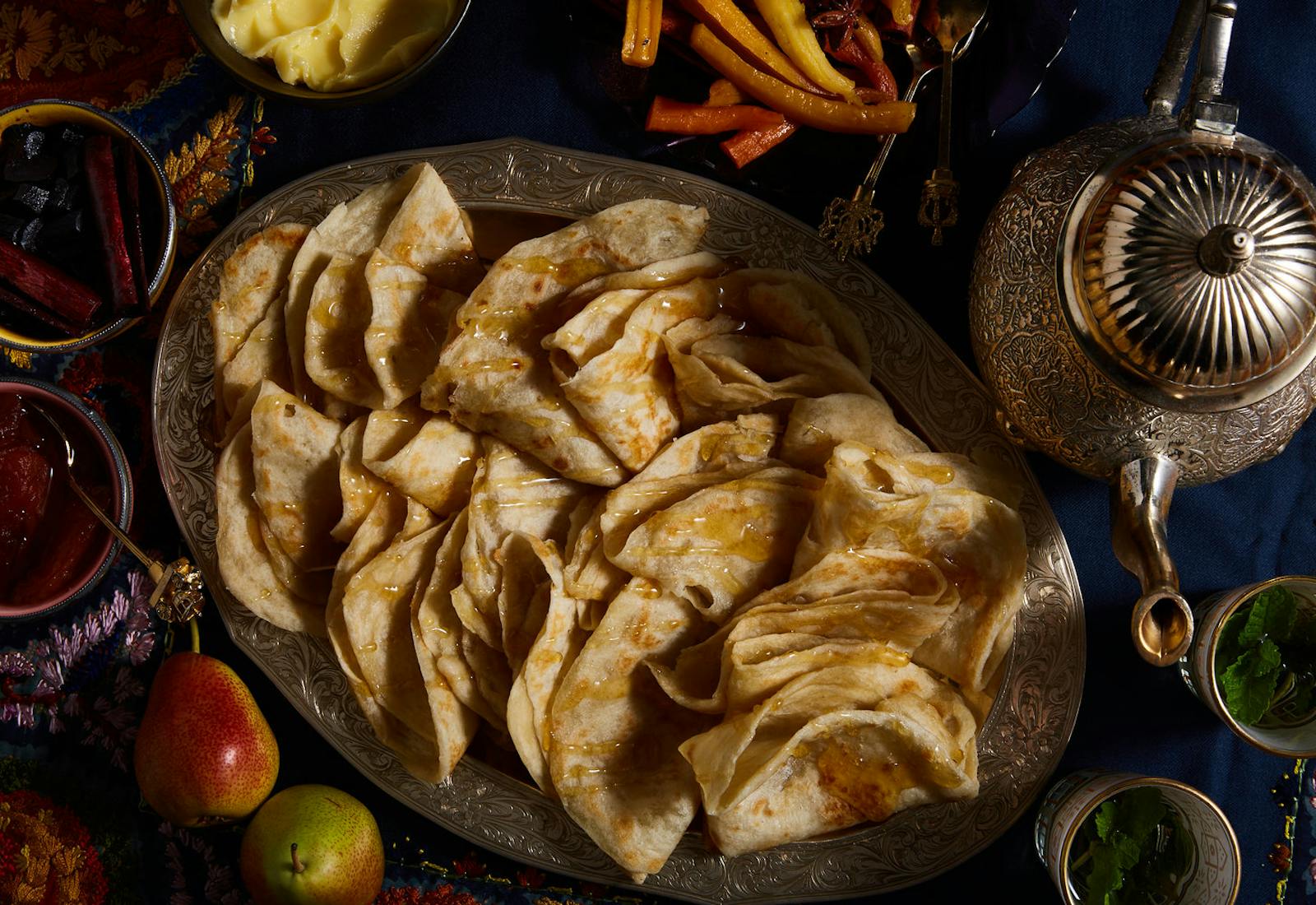
26. Mufleta (Moroccan Crepes)
Yield: One 12-14-inch mufleta stack (about 24 layers)Time: 1h plus rising timeThis recipe is featured in our cookbook "The Jewish Holiday Table: A World of Recipes, Traditions & Stories to Celebrate All Year Long." For more holiday recipes from around the world, get your copy!
This recipe was shared by Ruth and Gabriel Stulman. Read more about his family in "Sharing Mimouna With Neighbors — in Morocco and Virginia" and try their recipes for petits gateaux (pistachio cookies) and boules aux noix (walnut balls).
Ingredients
- 4 cups all-purpose flour
- 1 teaspoon sugar
- 2 teaspoons kosher salt
- 1 packet (2¼ teaspoons) active dry yeast
- 1½ cups lukewarm water
- About ½ cup neutral oil, such as canola, plus more for the bowl and work surface
- Melted butter for drizzling
- Honey for drizzling
Preparation
Step 1
Put the flour, sugar, salt, and yeast in the bowl of a stand mixer fitted with the dough hook and mix on low speed until combined. With the mixer running, slowly stream in the water. If the dough seems dry at this point, add a bit more water, a teaspoon at a time, until the dough just comes together. Increase the mixer speed to medium and mix the dough for 10 to 12 minutes, until uniform and smooth.
Step 2
Transfer the dough to a lightly oiled bowl, cover with plastic wrap, and let rise until doubled in size, about 40 minutes.
Step 3
Pour the oil onto a rimmed baking sheet and spread it evenly. Turn the dough out onto the oiled pan and use a knife to cut it into 24 equal pieces about the size of a gold ball.
Step 4
To shape the dough, stretch one-quarter of one piece of dough out, over, and into the center of the dough ball. Do this three more times, working your way around the dough--think of creating a little parachute with the dough where the four quarters meet at the middle. Make a ring by connecting the thumb and forefinger of one hand. Take the dough ball and, smooth top side first, push it through the ring, which will slightly stretch the surface of the dough, tightening the ball. Pinch the bottom of the ball closed. Coat both sides of the ball with a bit more oil from the baking sheet and place it seam side down on the sheet. Continue to shape the rest of the dough balls.
Step 5
Heat a large nonstick skillet over medium-high heat. Lightly oil a clean work surface.
Step 6
Set a dough ball on the oiled work surface and, using your hands and a rolling pin, stretch and flatten it into a 12- to 14-inch paper-thin round (try not to make any holes, but if it happens, it’s okay). Carefully lift the dough and lay it in the hot pan. You'll have a few seconds to reposition any folds or creases, but don't worry if it's not perfectly flat. Immediately start stretching your next layer. Once the dough in the skillet starts to brown lightly on the bottom, use a spatula to carefully flip it over. Lay the second stretched dough round directly on top of the first and immediately start stretching your next piece of dough.
Step 7
When the bottom of the dough in the pan is lightly golden, 2 to 3 minutes, flip the two layers over. Lay the third round of stretched dough on top of the stack.
Step 8
Repeat this process of stretching, flipping, and adding to the dough stack until all of the layers are stacked in the skillet, like a giant crepe cake. If after you've stacked a dozen or so layers the stack becomes too difficult to flip as one, set that stack aside and start fresh with the rest of your dough. Adjust the heat as necessary while you work so that the layers don't take on too much color. Remove the stack from the skillet and place on a large plate or serving dish.
Step 9
Serve the mufleta immediately. To eat, each person should peel away a layer of mufleta from the stack, drizzle it with butter and honey, and roll it into a cylinder or fold into quarters.
Shared by Arielle (Nir) Mamiye and Efrat Navon
27. Rifat (Moroccan Tea Biscuits)
Yield: 10 to 15 servingsTime: 1 h 30 minShared by Arielle (Nir) Mamiye and Efrat Navon
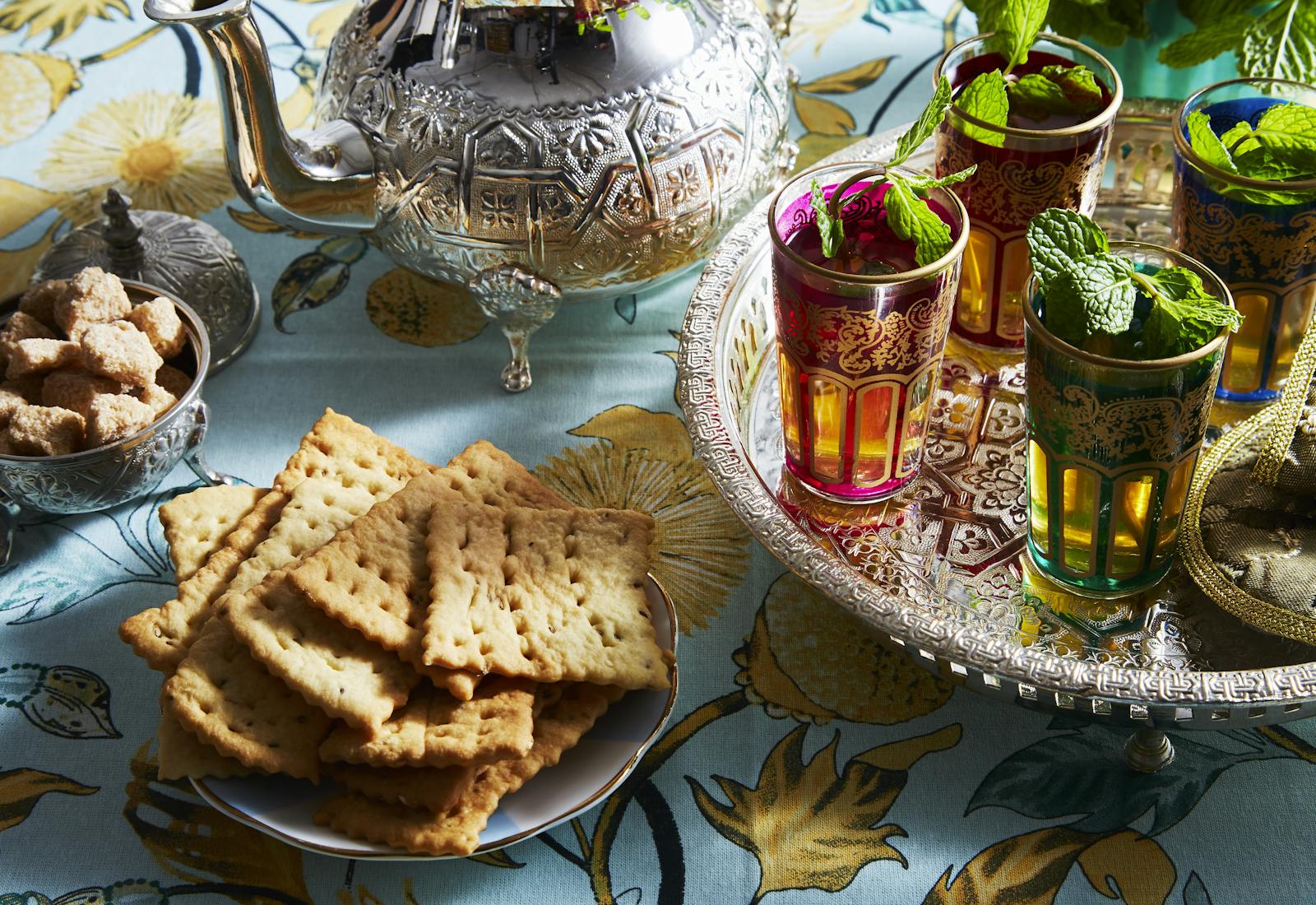
27. Rifat (Moroccan Tea Biscuits)
Yield: 10 to 15 servingsTime: 1 h 30 minThis recipe was shared by Arielle (Nir) Mamiye and Efrat Navon. Read more about their family in "A Moroccan Grandmother's Love Is Rolled Into Her Couscous" and try their recipe for hand-rolled couscous.
Esther traditionally prepared rifat with a pasta machine. The rifat can also be prepared by hand using a rolling pin. Rifat can be stored in an airtight container for up to 10 days.
Ingredients
- 1 cup vegetable oil
- 1 ½ cups orange juice
- 1 ½ cups granulated sugar
- 3 eggs
- 6 ½ cups all purpose flour
- 1 ½ tablespoons baking powder
- 2 tablespoons sesame seeds
- 2 tablespoons anise seeds
Special equipment
Preparation
Step 1
Make the dough: Place the vegetable oil, orange juice, sugar, and eggs into a medium sized mixing bowl. Mix until combined well. Set aside. Sift the flour and baking powder into a seperate large mixing bowl. Add the anise and sesame seeds and stir to combine. Make a large well in the center of the bowl. Gently pour the wet ingredients into the well. Use a fork to slowly stir in the edges of the well to mix the liquid ingredients with the dry ingredients. Continue stirring until the mixture forms a dough. Knead the dough in the bowl for about 2 to 4 minutes until the dough is completely smooth and the ingredients are well incorporated. The dough should be sticky. Cover the bowl with a kitchen towel and set aside at room temperature for about 30 minutes.
Step 2
Preheat oven to 325 degrees. Line four large baking sheets with parchment paper and set aside.
Step 3
Shape the dough: Attach a pasta machine to a counter or add a pasta extension to stand mixer. Transfer the dough onto a floured surface and divide it into 6 even pieces. Take one piece of dough and set the remaining 5 pieces aside. Use your fingers to flatten the dough into a rectangle about 2 inches thick. Starting at the thickest setting of the pasta machine (most likely #1), feed the dough through the machine starting with the short edge of the rectangle and gently catch the flattened dough on the other end with your hand. Reduce the pasta machine to the next narrowest setting (most likely #2), and again feed the short side of the dough through the machine again. The dough should be about ⅛ inch thick. Place the rolled out dough onto a floured surface.
If you are using a rolling pin, see the cook's note below.
Step 4
Using a fluted pastry wheel or a sharp knife, cut the dough into smaller rectangles of about 3 x 2 ½ inches. Peel off any excess dough and reserve. Once the biscuits are shaped, use a pastry hole maker or a fork to poke several holes into each biscuit. Gently transfer the shaped biscuits onto the parchment lined baking trays. If needed, use a knife to help peel the biscuits off of the floured surface. Repeat the dough shaping, cutting and poking process with the remaining 5 pieces of dough.
Step 5
Once the biscuits are shaped, use a pastry hole maker or a fork to poke several holes into each biscuit. Gently transfer the shaped biscuits onto the parchment lined baking trays. If needed, use a knife to help peel the biscuits off of the floured surface.
Step 6
Once all the biscuits are placed on baking trays, transfer them into the oven and bake for about 20 to 25 minutes until golden brown. If needed, bake the biscuits in batches of 2 baking trays at a time. You can shape all the excess dough into one unified piece and make more biscuits using this dough.
Step 7
Set the rifat aside to cool for about 10 minutes.
Step 8
Serve rifat with a side of moroccan tea.
Shared by Michel Thouati
28. Mint Tea With Pine Nuts, Honey, and Lemon
Yield: 8 servingsTime: 10 minShared by Michel Thouati

28. Mint Tea With Pine Nuts, Honey, and Lemon
Yield: 8 servingsTime: 10 minRaised on French naval bases around the world, Michel Thouati spent long stretches of his childhood living far away from his extended family. When his father had time off, the family would visit and catch up with relatives. This included traveling to France to celebrate Passover with Michel’s maternal grandparents, Laure Orovida Benoliel and Robert Josue Benoliel. A prolific and knowledgeable cook, his grandmother Laure made tables full of food, featuring generations-old Sephardic recipes like lamb with peas, artichoke hearts and honey. “Just looking at the table was wonderful,” recalls Michel. In between courses, she served this tea with mint, lemon and pine nuts, a refreshing palate cleanser for guests.
This recipe was shared by Michel Thouati. Read more about his family in "Preserving a Five-Century Long Link to Andalusia at Passover and Beyond" and try his recipes for Lettuce and Fennel Salad, Orange and Olive Salad, and Guizadas de Pessah (Passover Almond Macaroons).
Ingredients
- 2 tablespoons gunpowder tea
- 1 bunch fresh mint or spearmint
- Seeds of 4 green cardamom pods
- 8 teaspoons whole pine nuts
- 1 cup honey
- Juice of 1 lemon
Preparation
Step 1
Place the gunpowder tea and cardamom seeds in a tea ball. Add the tea ball into a teapot with 2 pints of boiling hot water. Steep for 3 minutes, make sure not to steep the tea for too long. Remove the tea ball.
Step 2
Bruise the mint with the back of a wooden spoon. Set aside.
Step 3
Set 8 glass tea cups on the table. Put 2 tablespoons of honey into each glass. Add 3 large mint sprigs and 1 teaspoon of pine nuts into each glass. Pour the tea into each glass. Add about ½ teaspoon of lemon juice into each glass.
Step 4
Serve hot.



